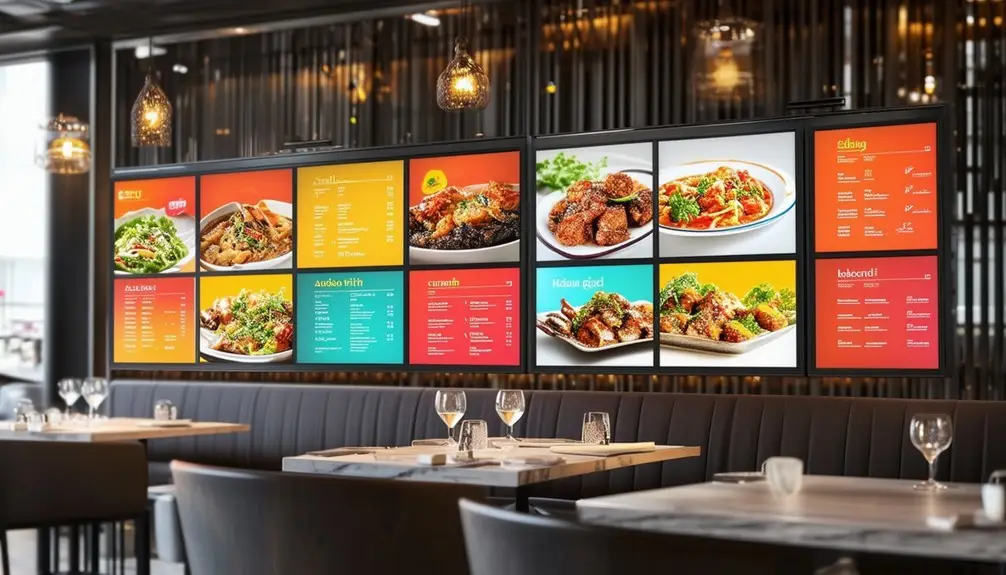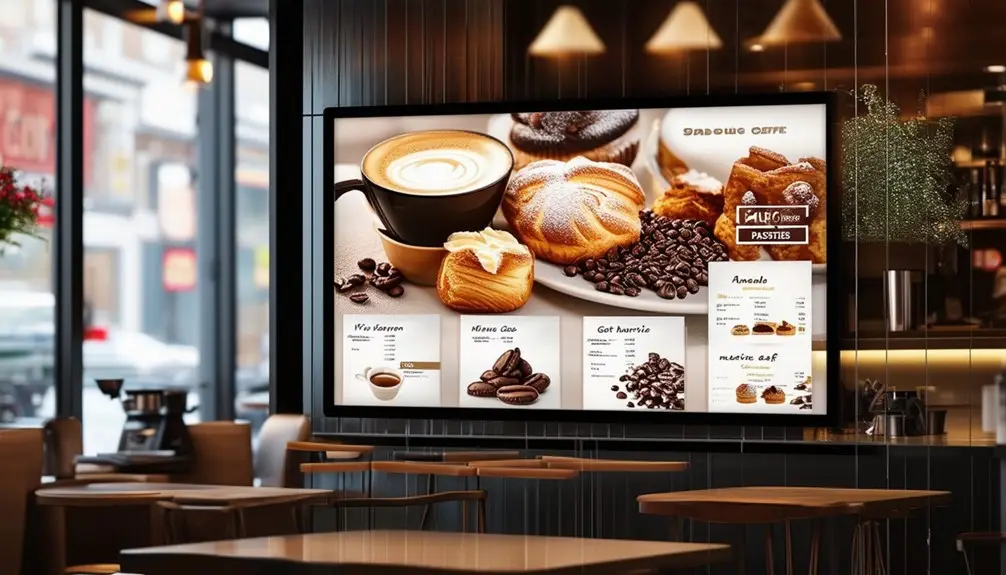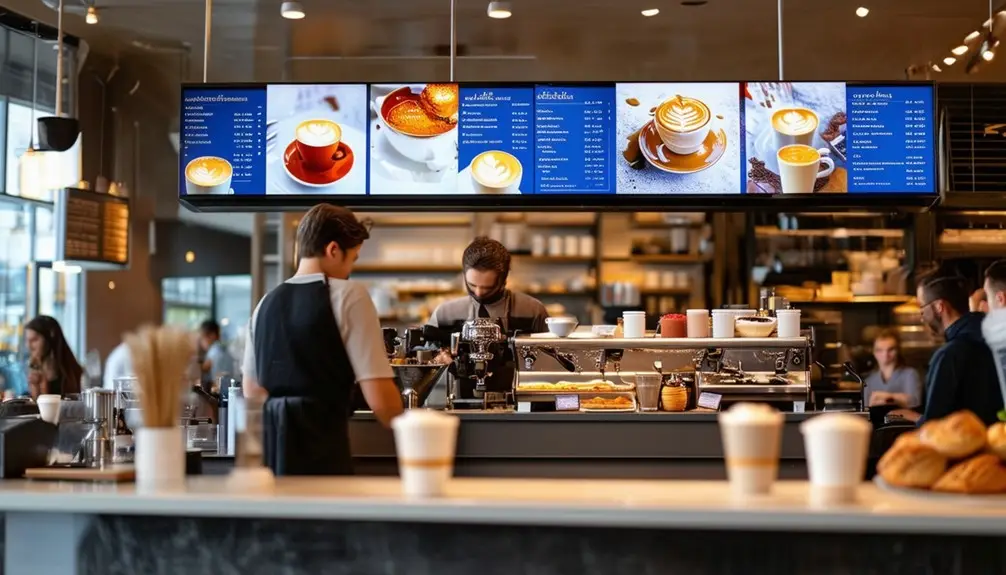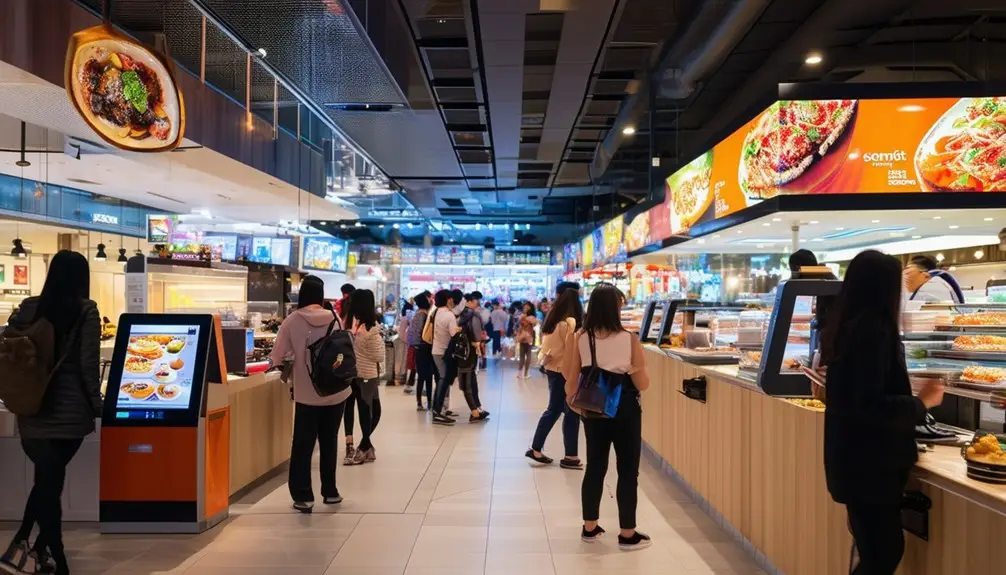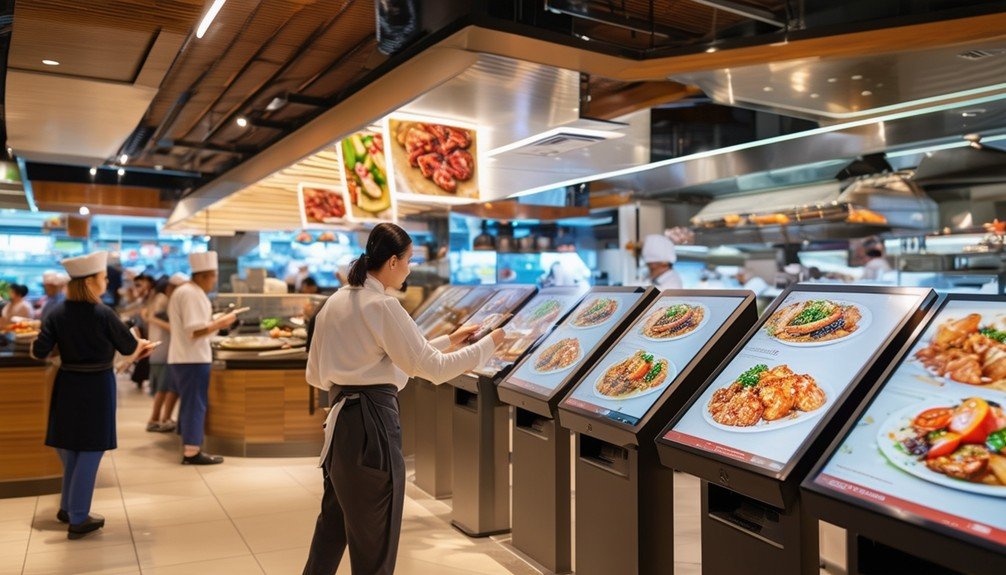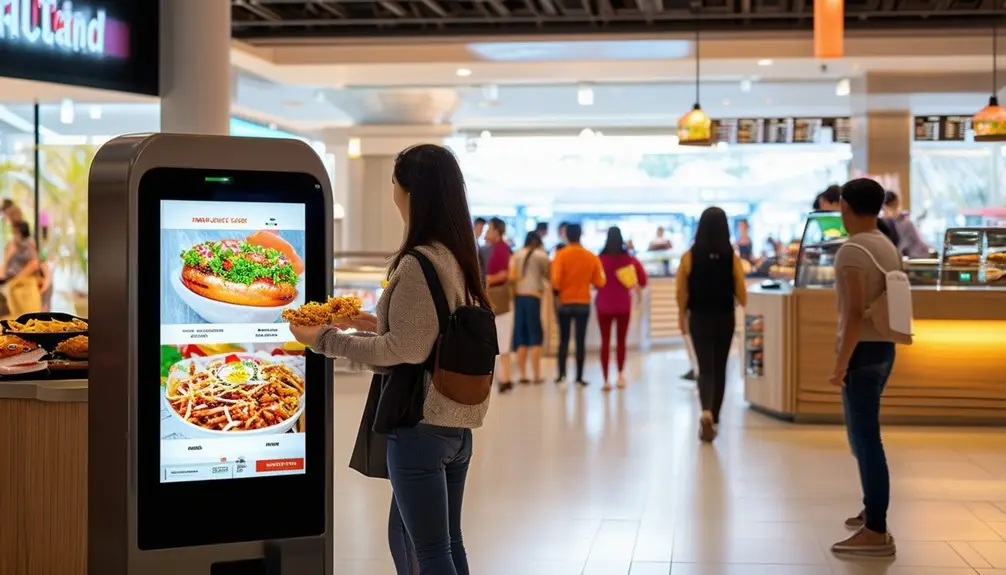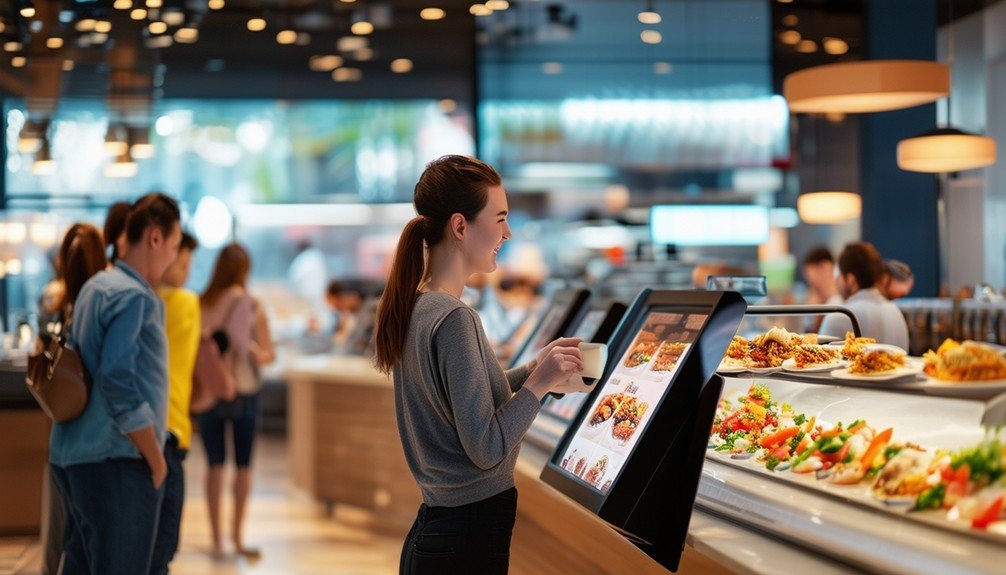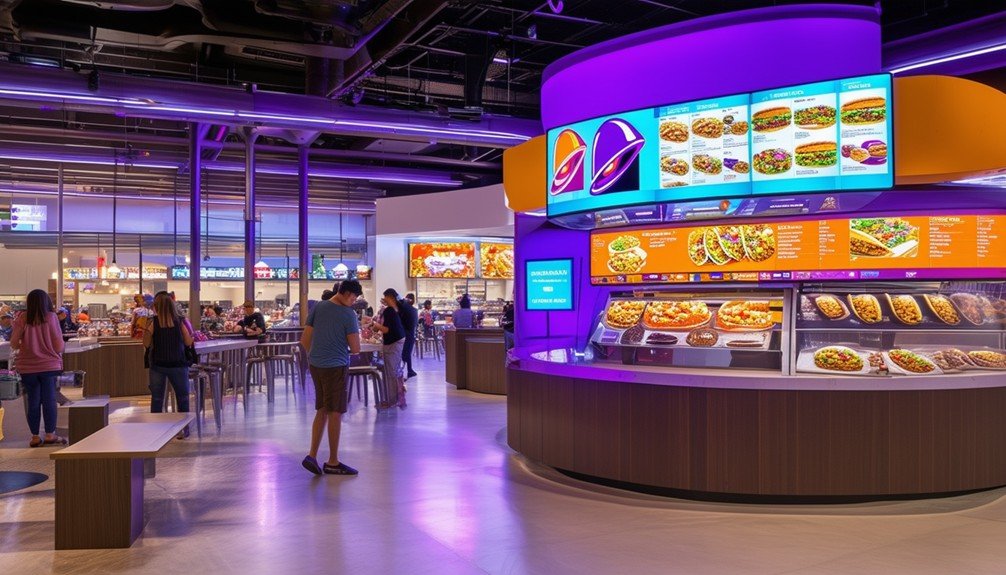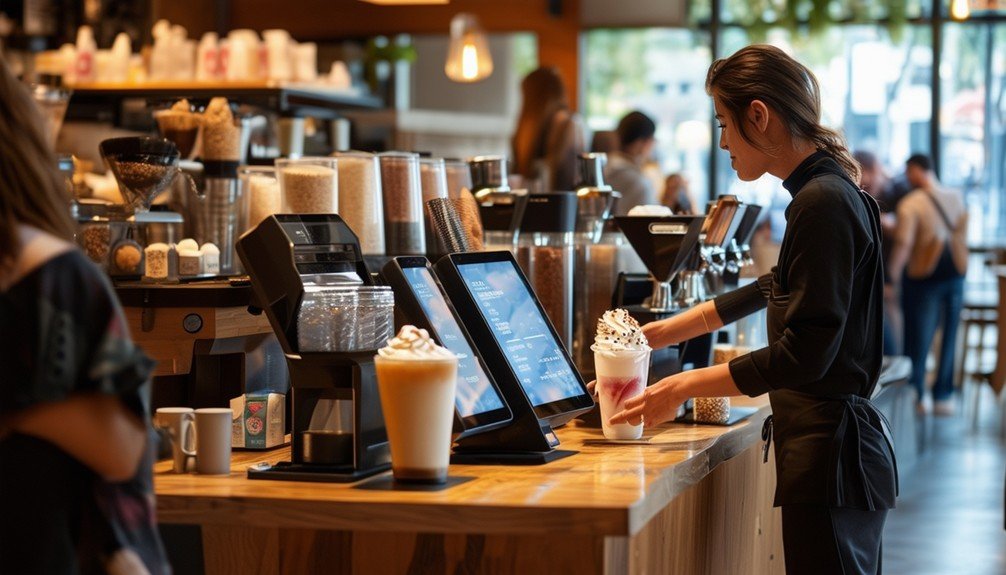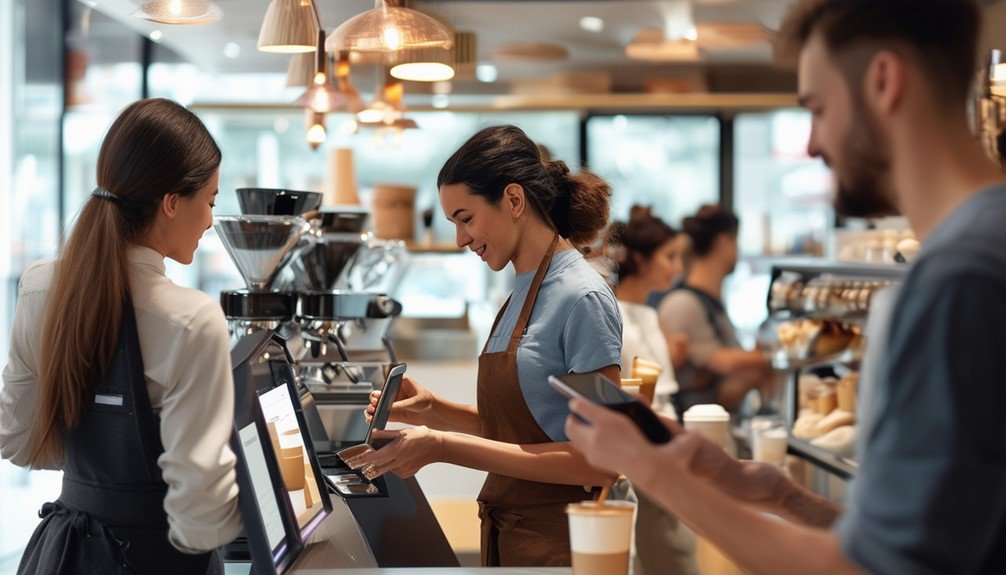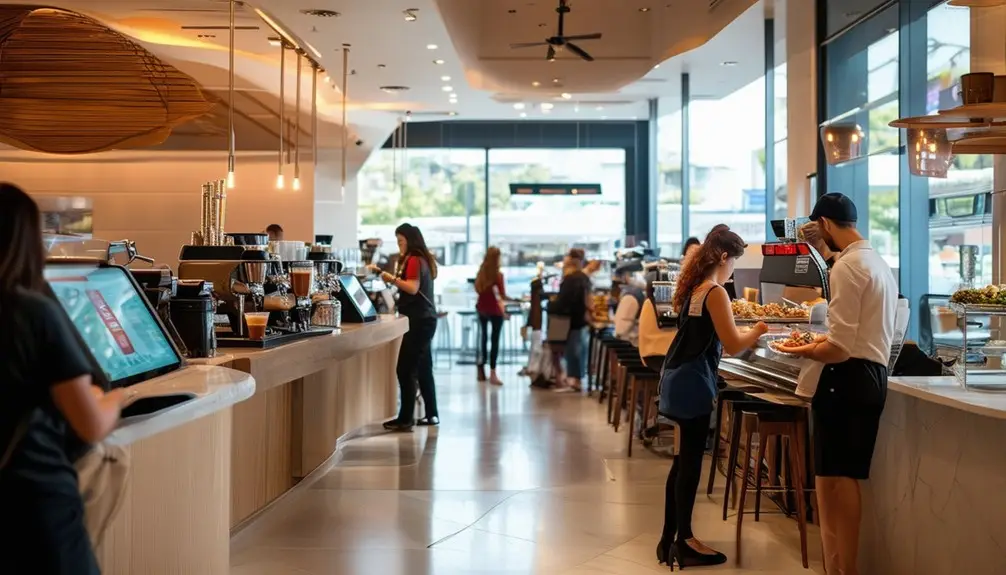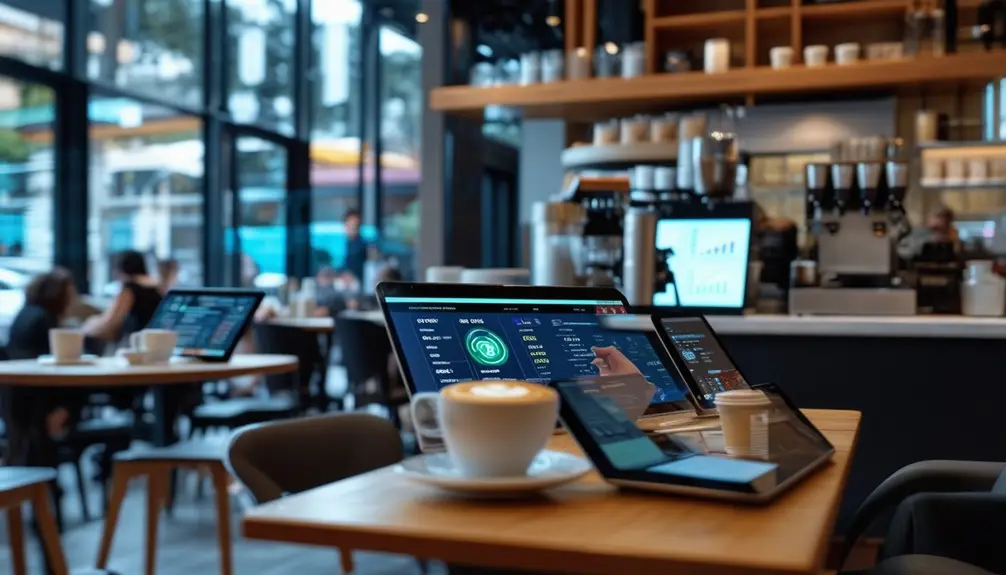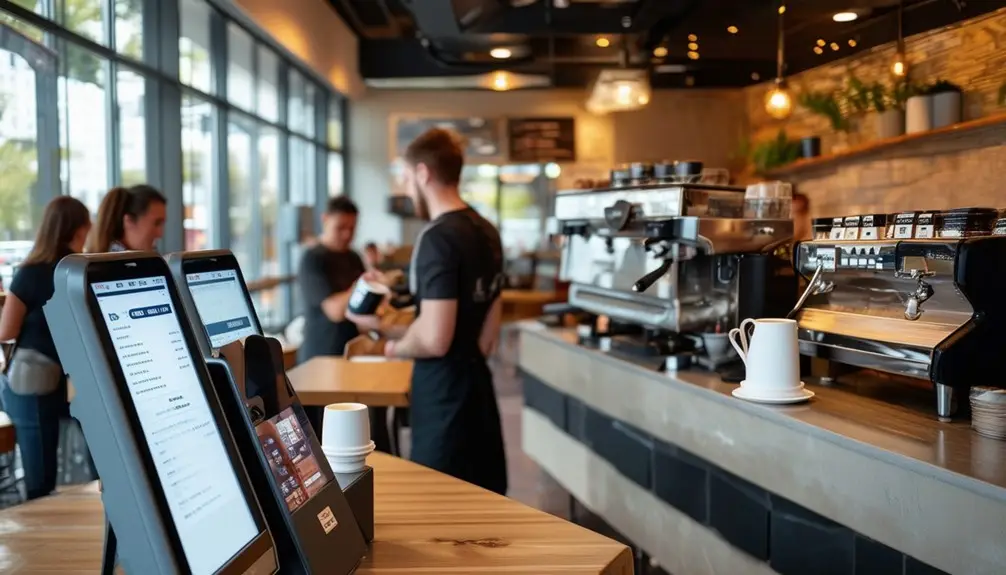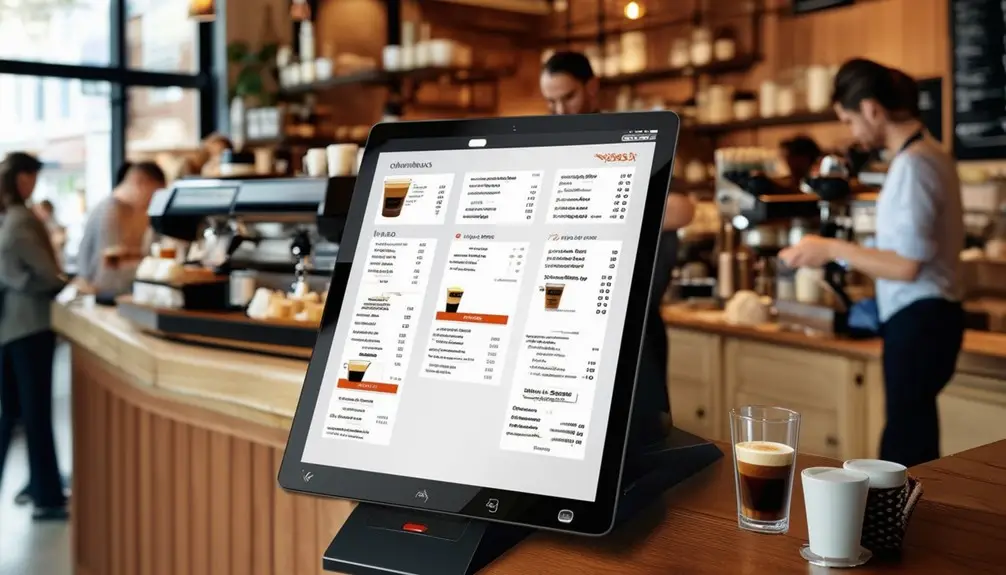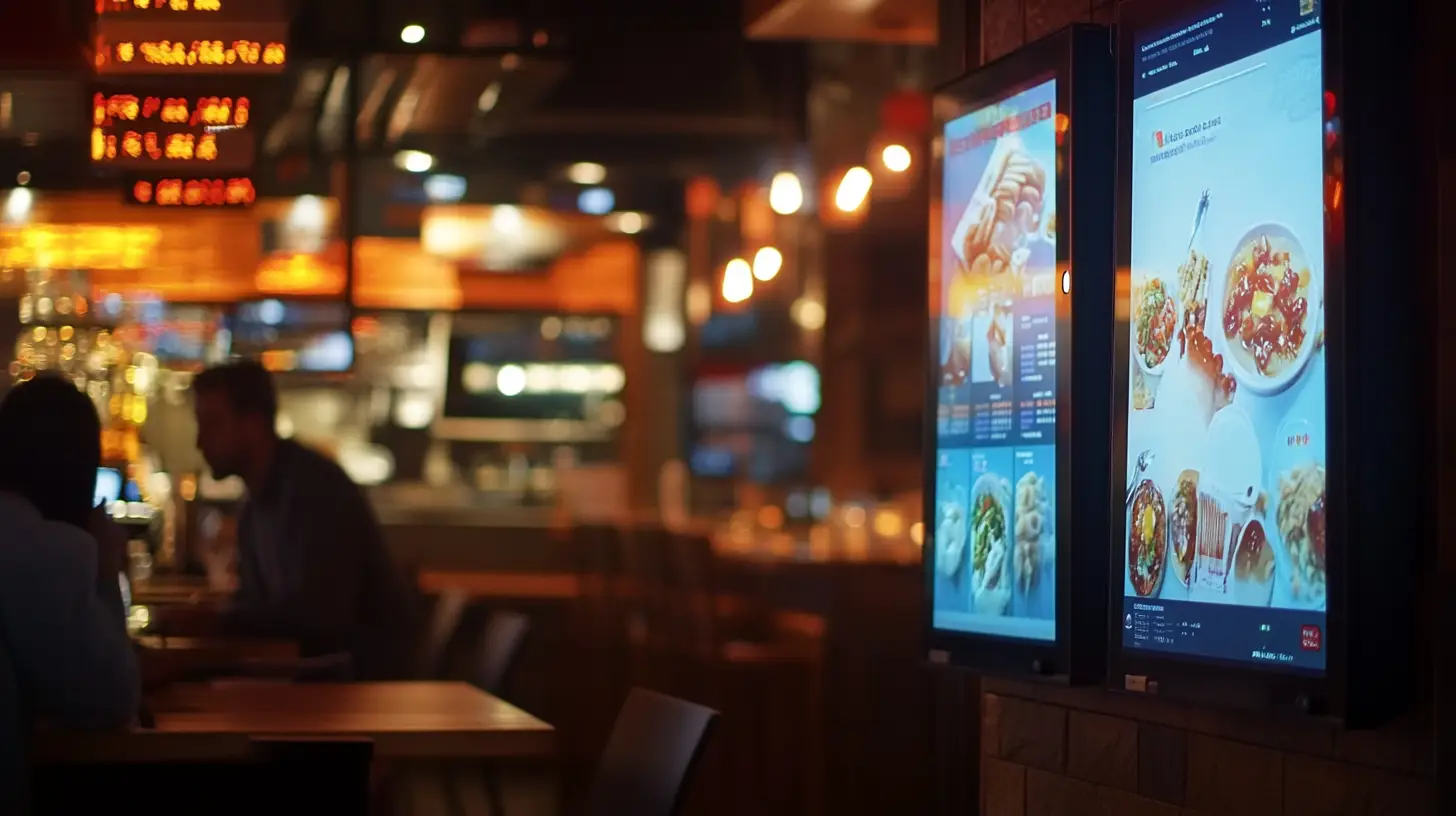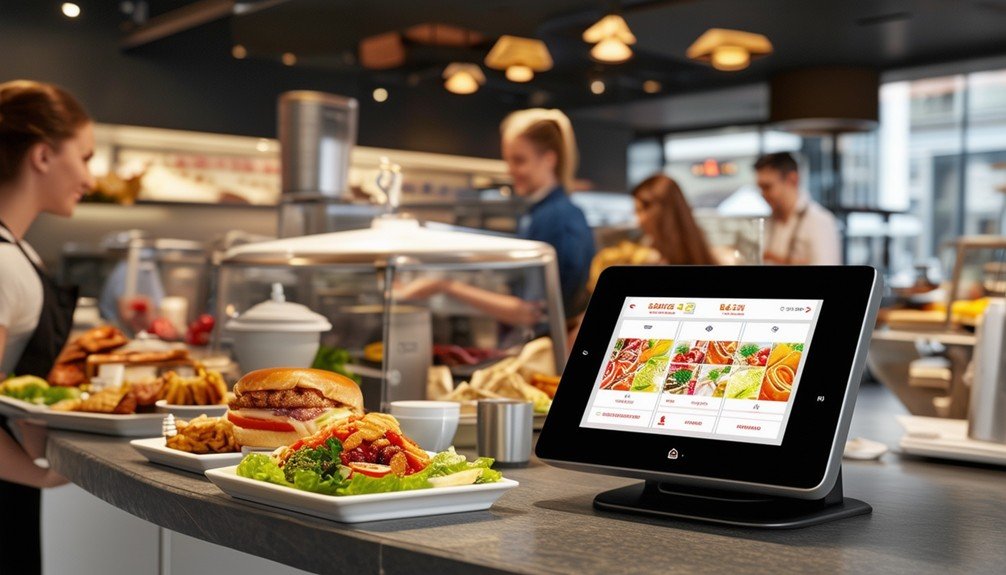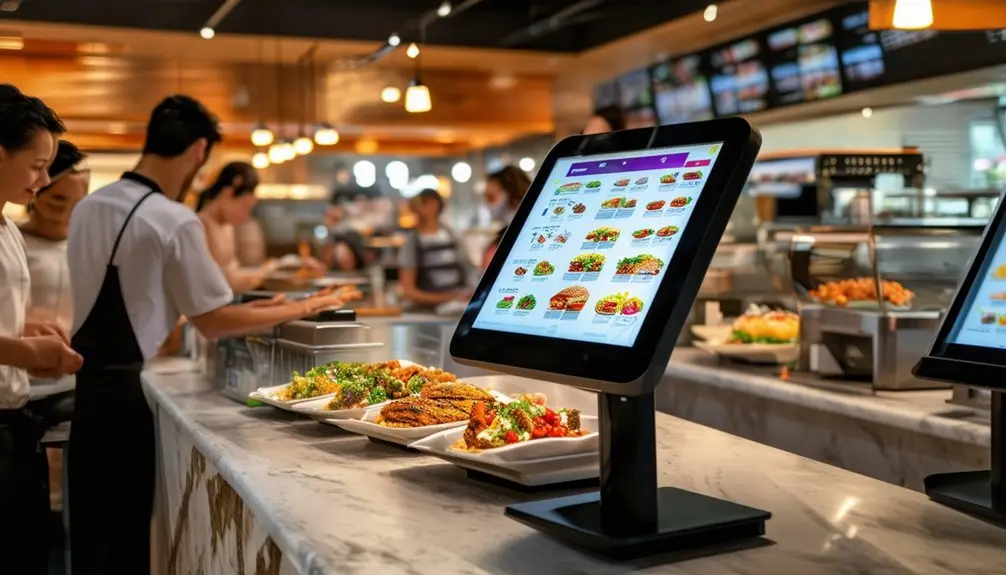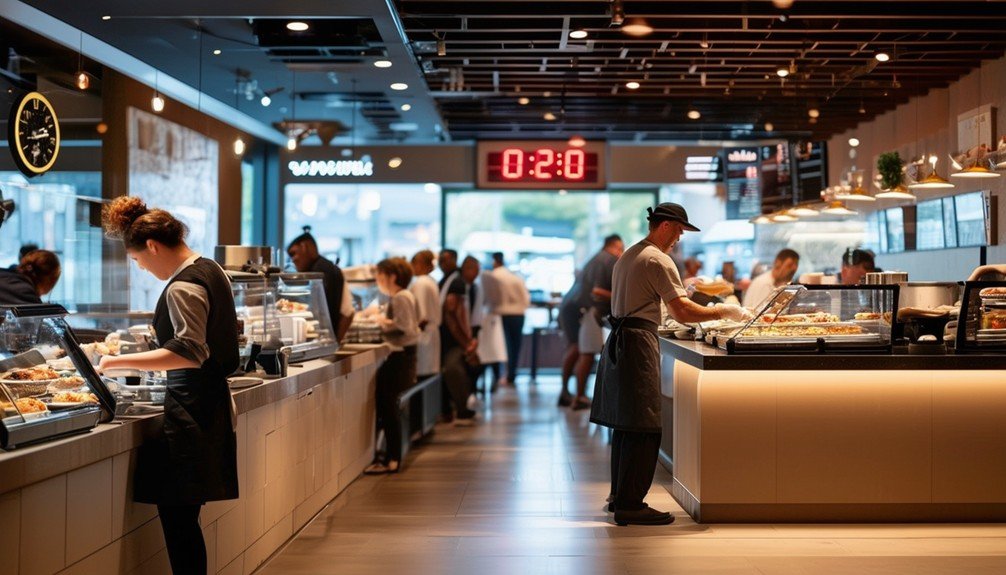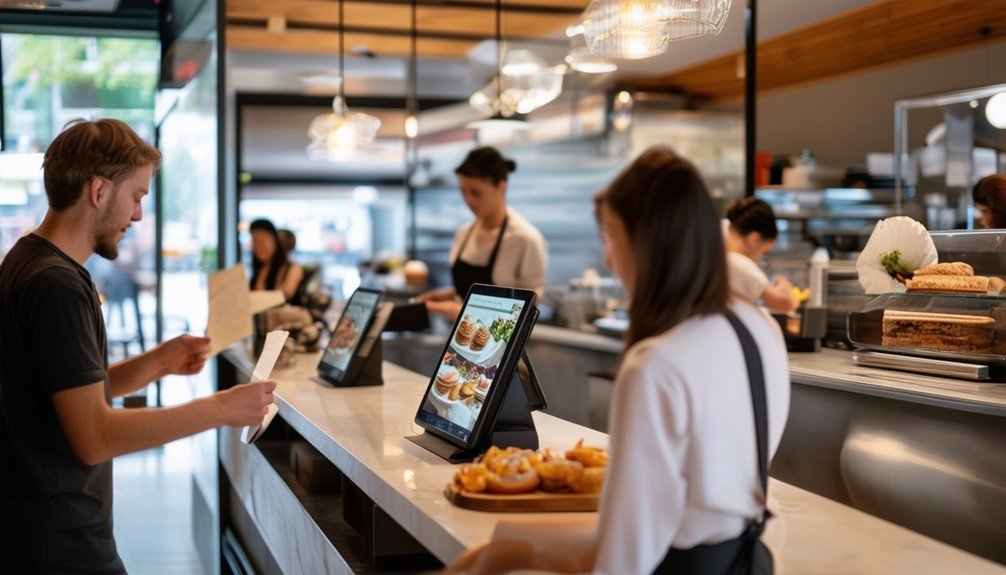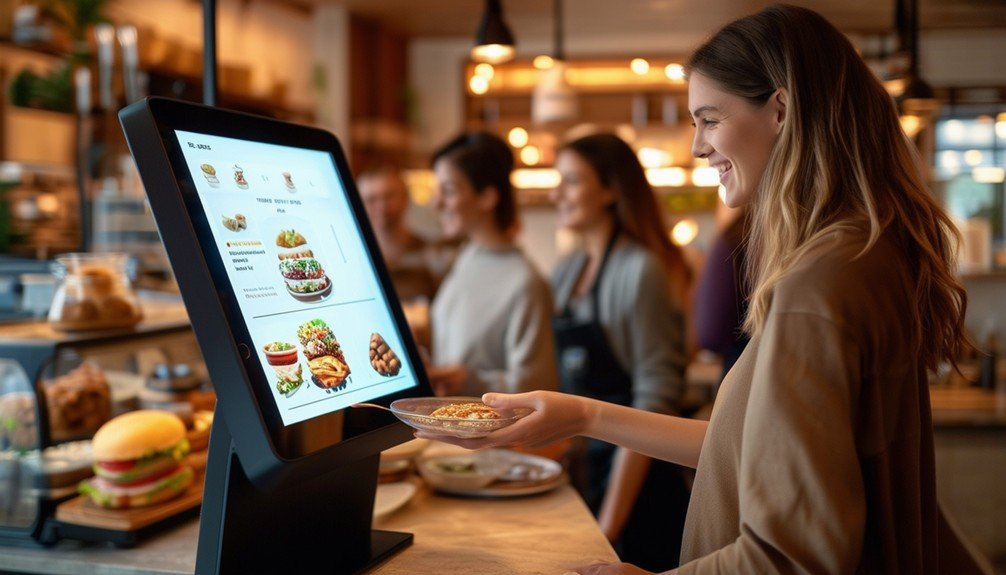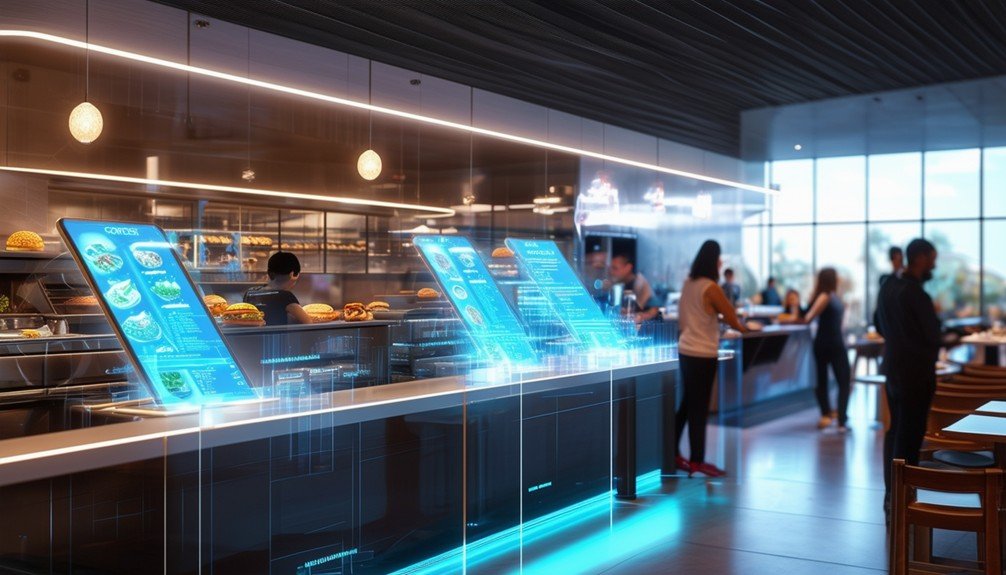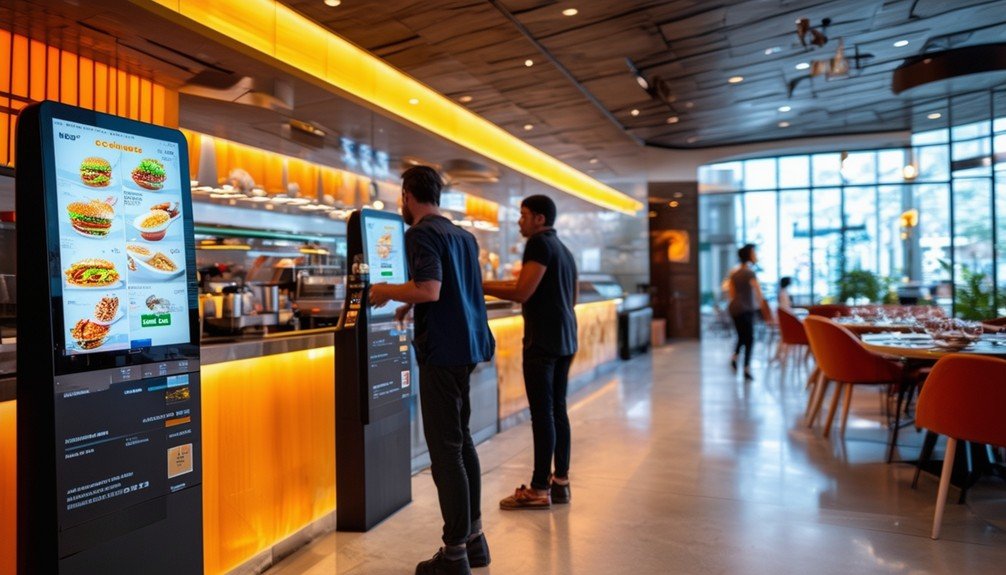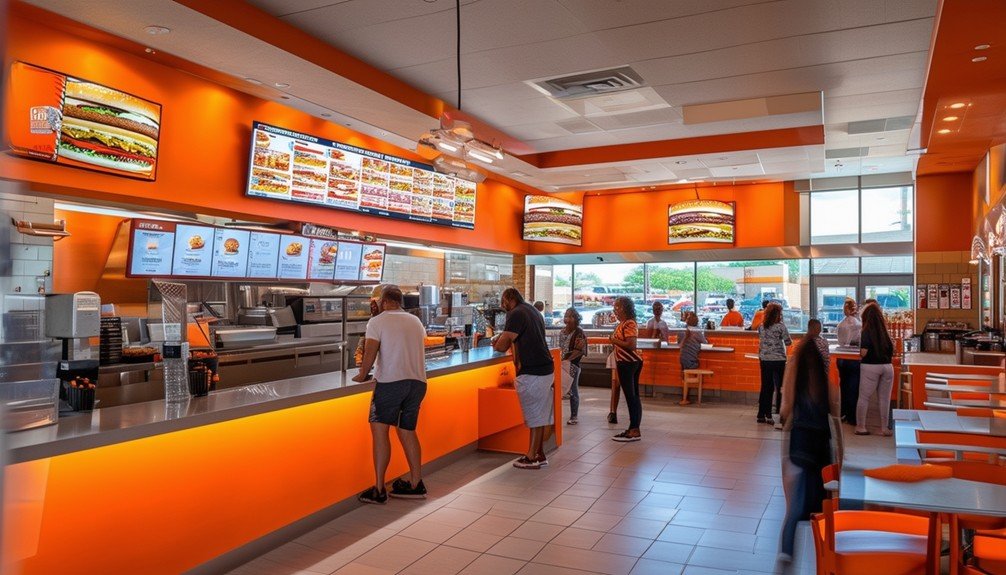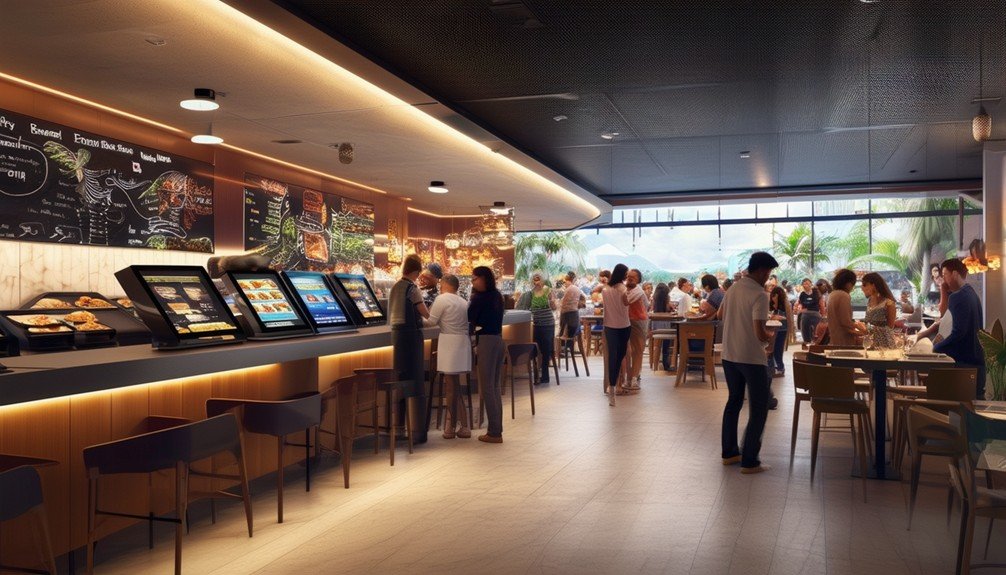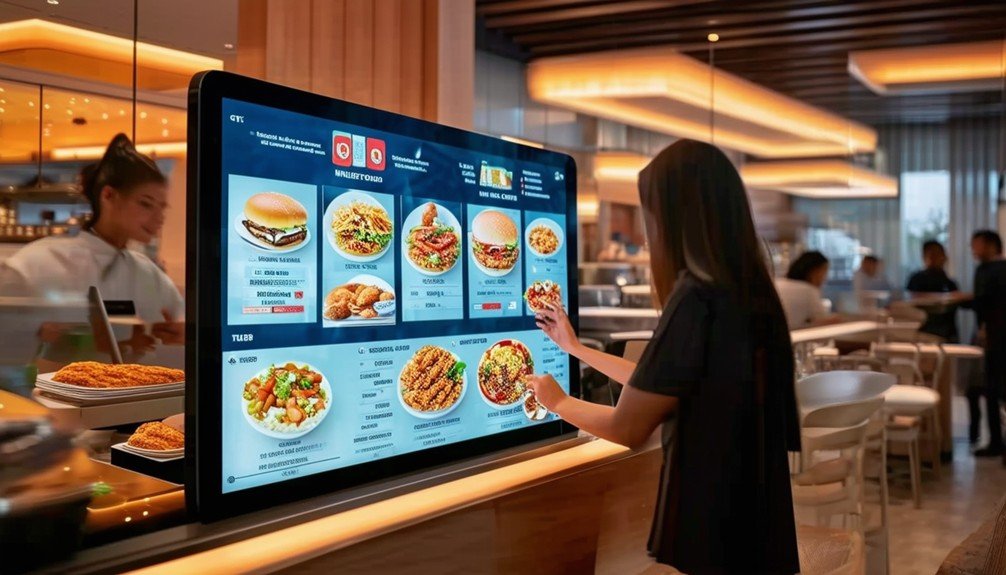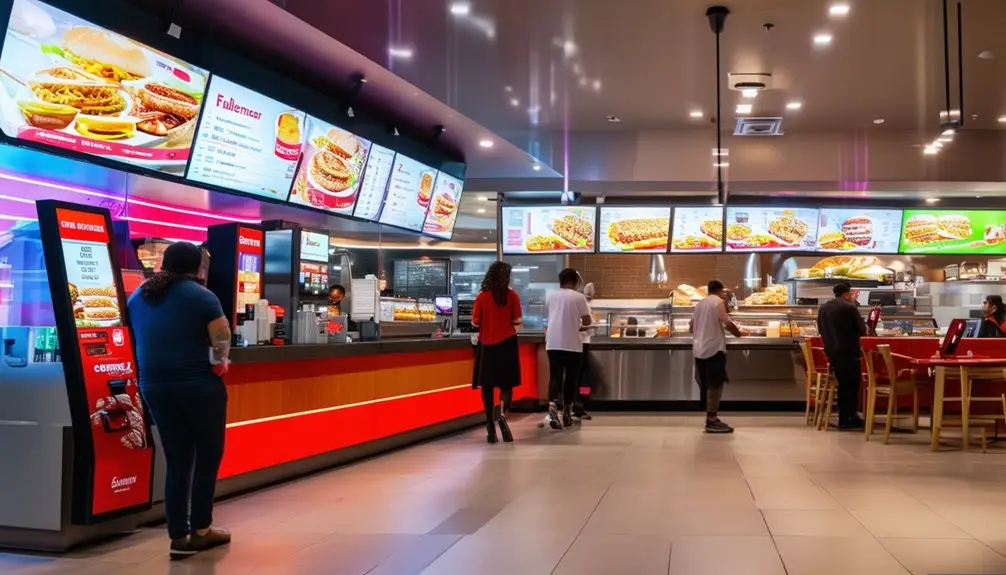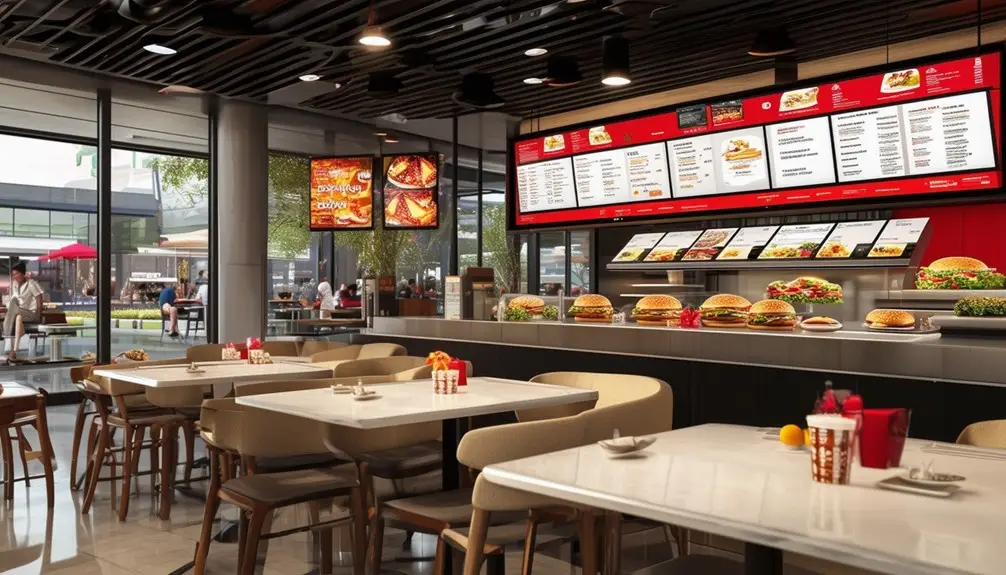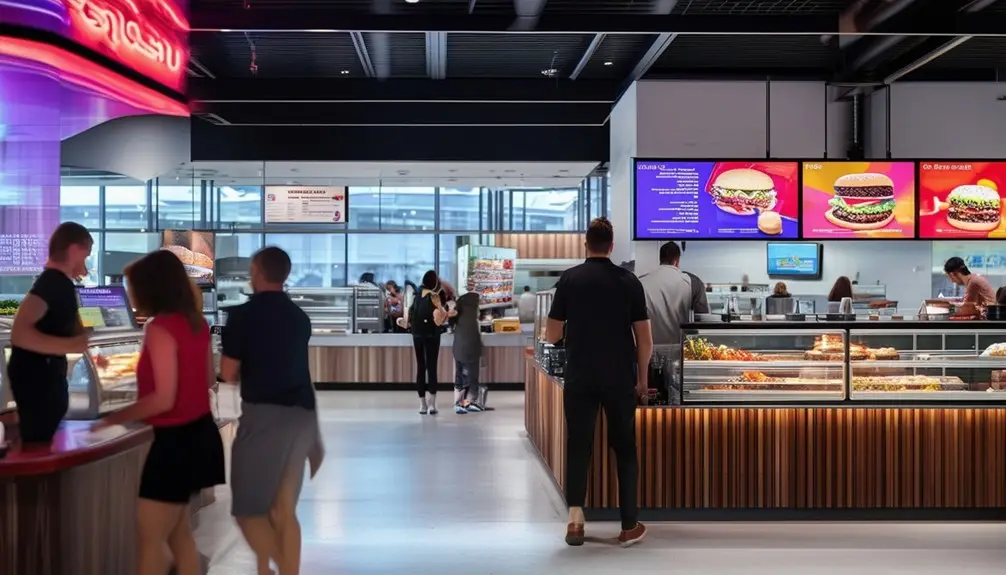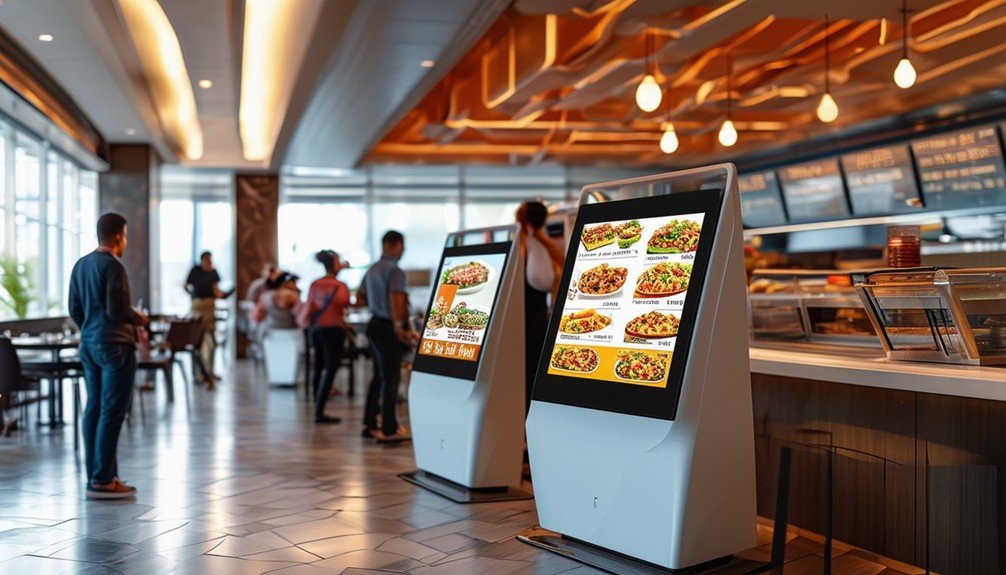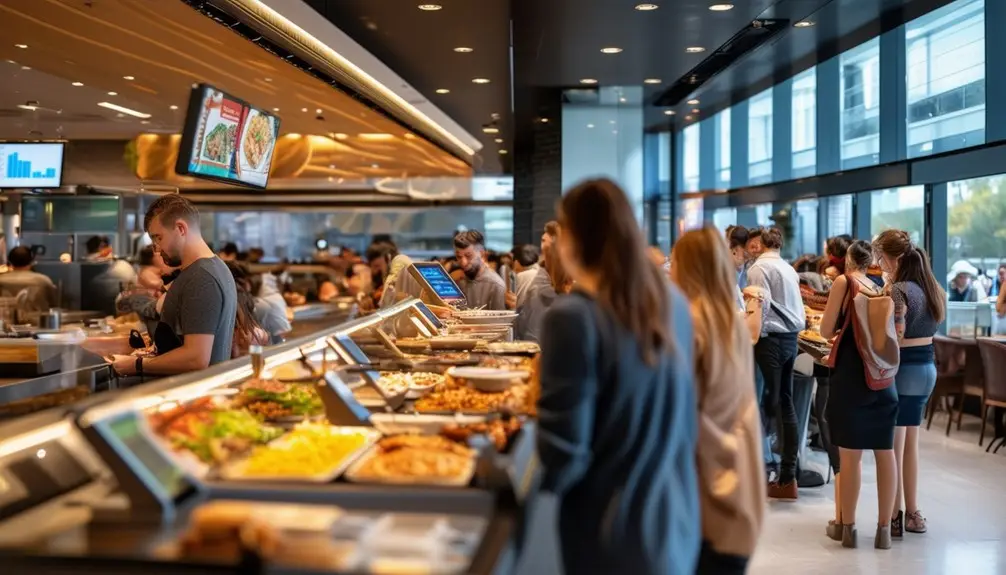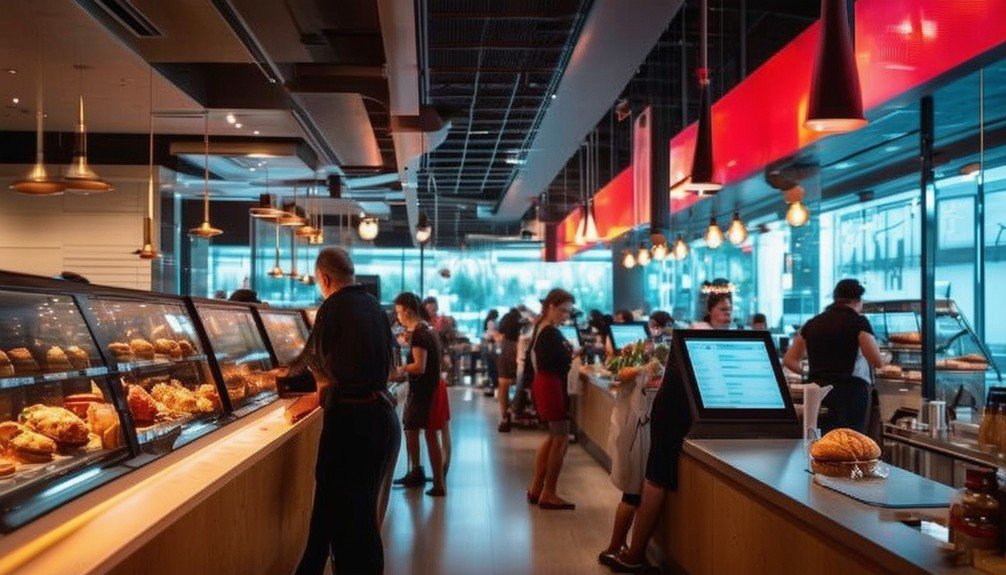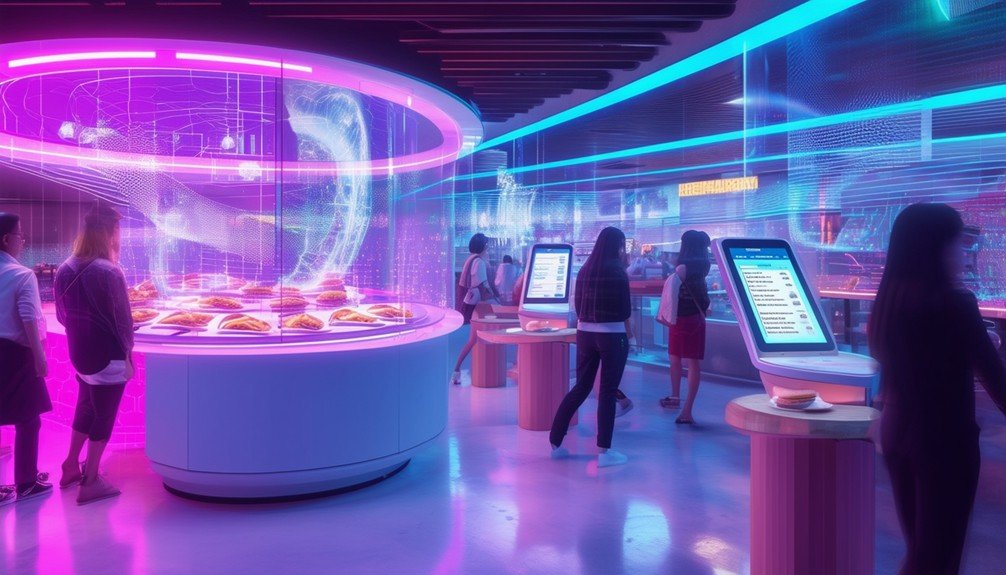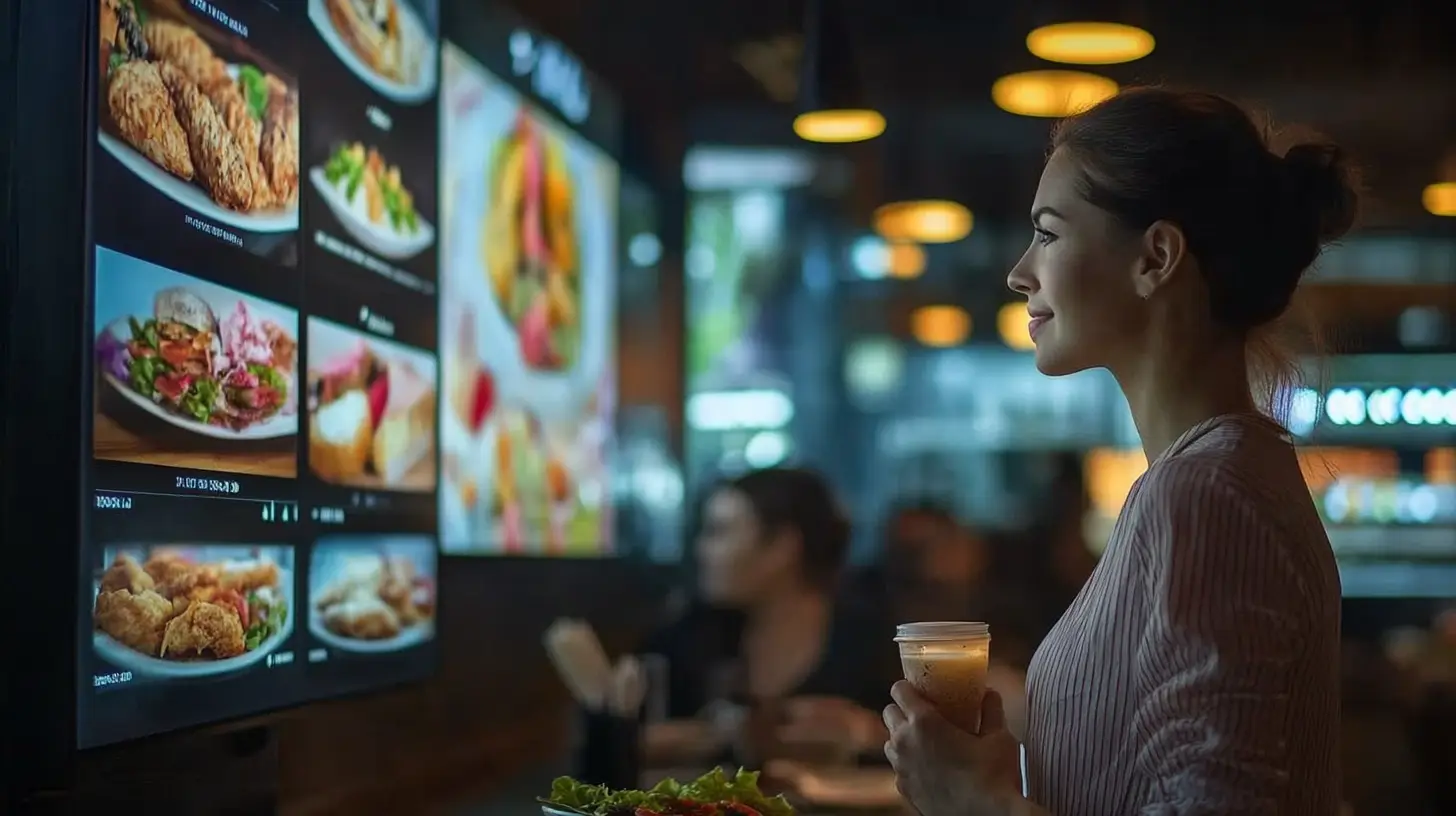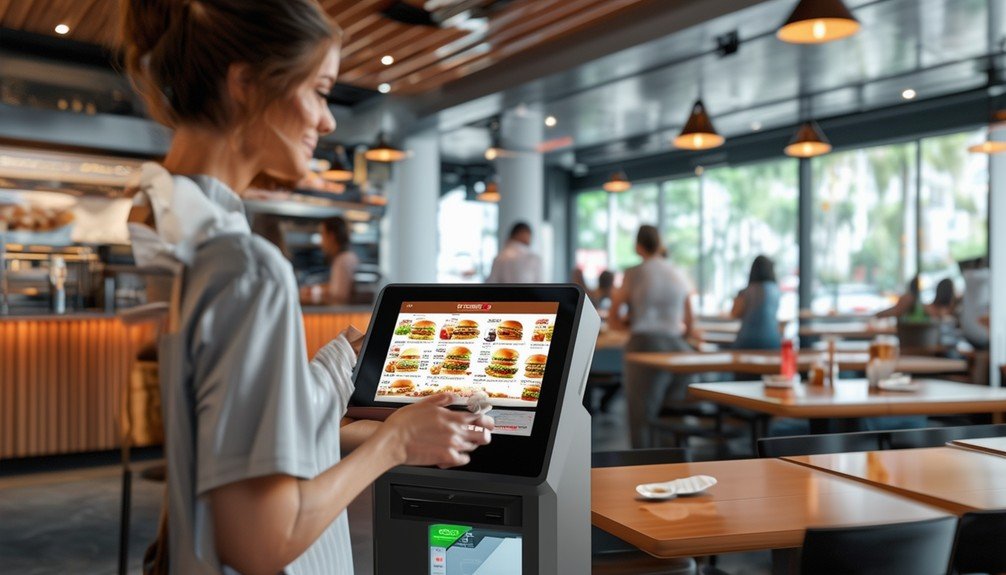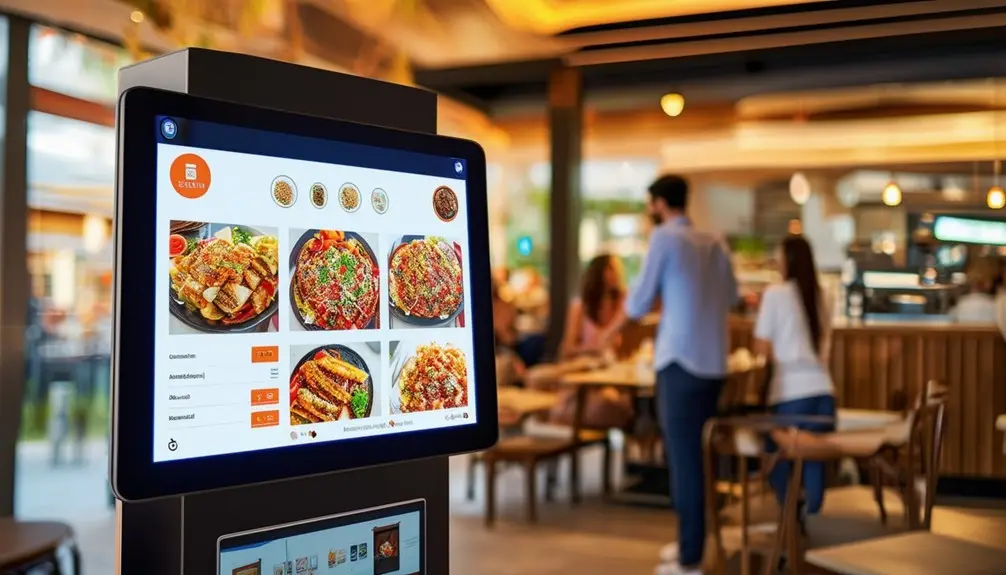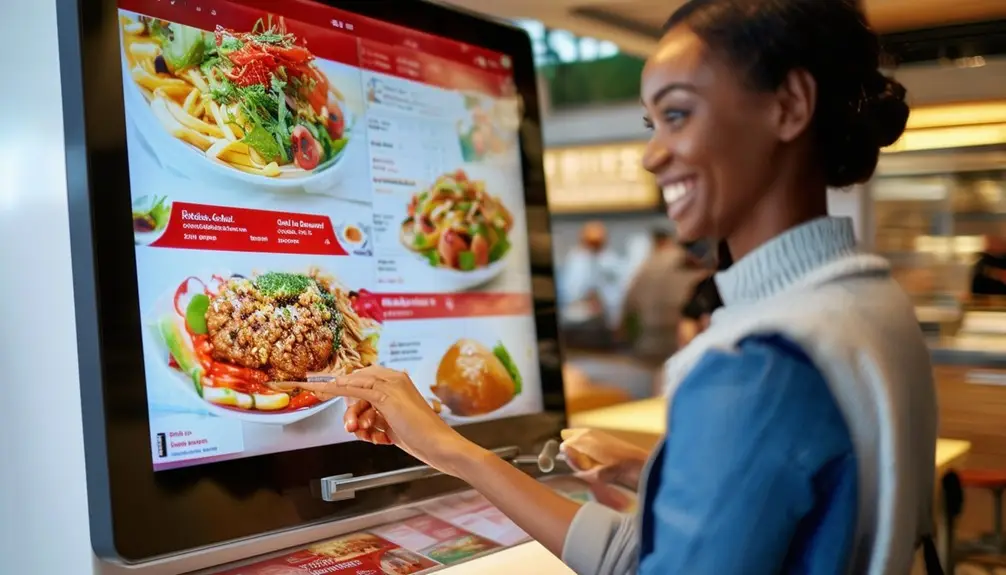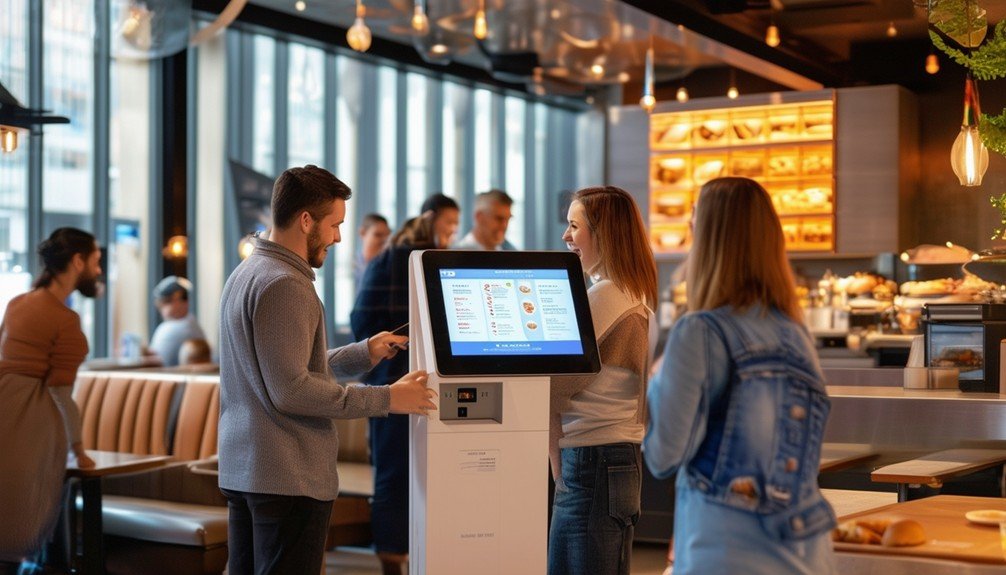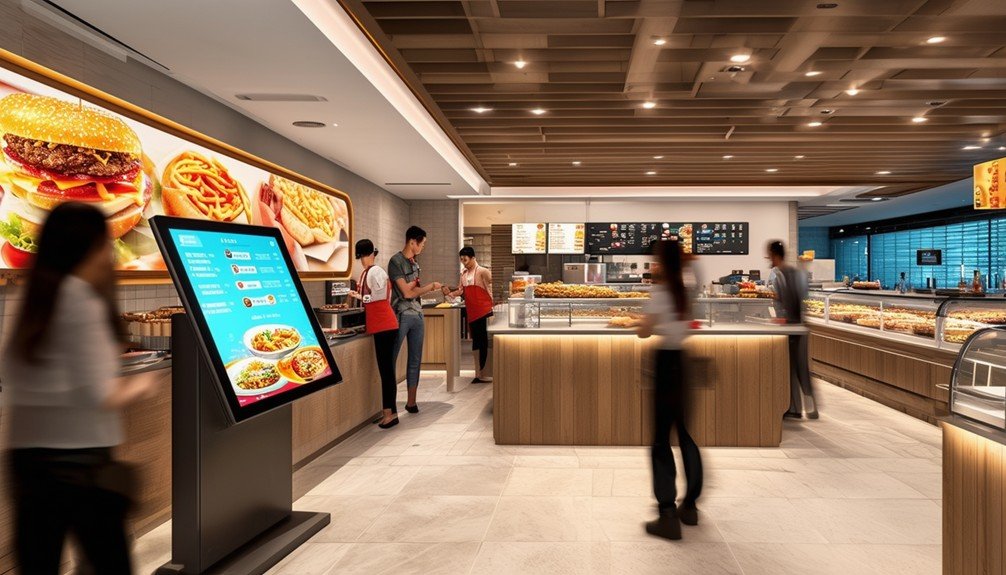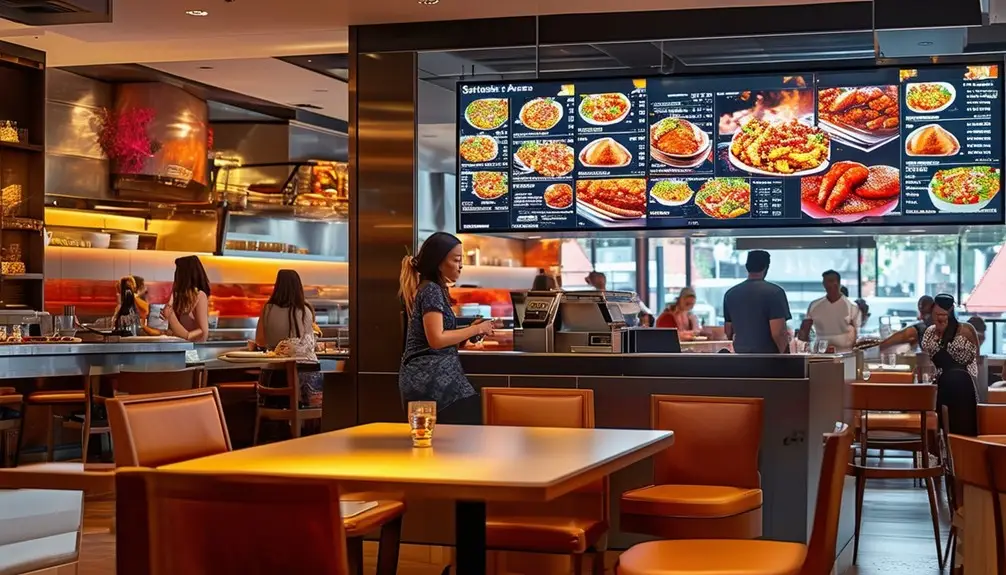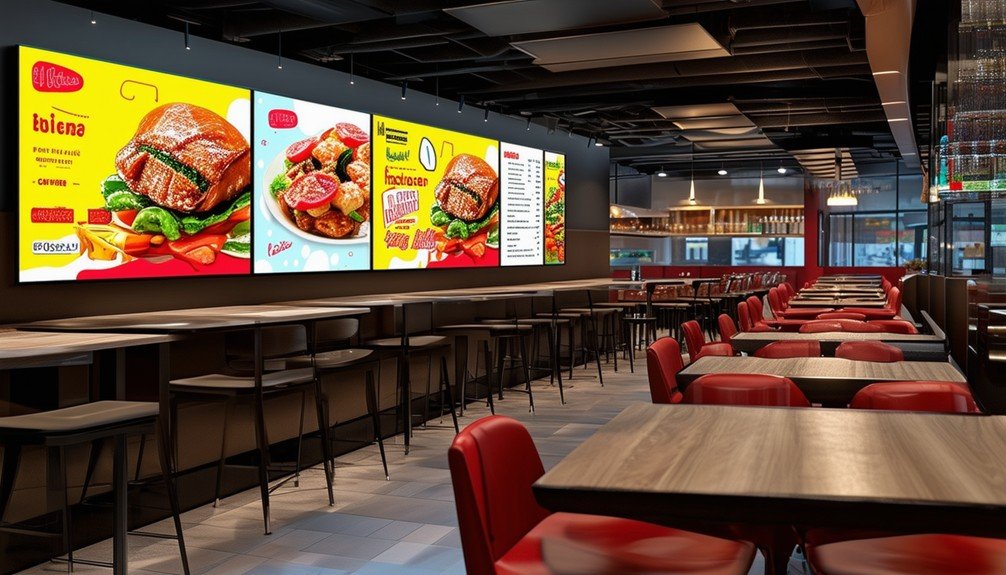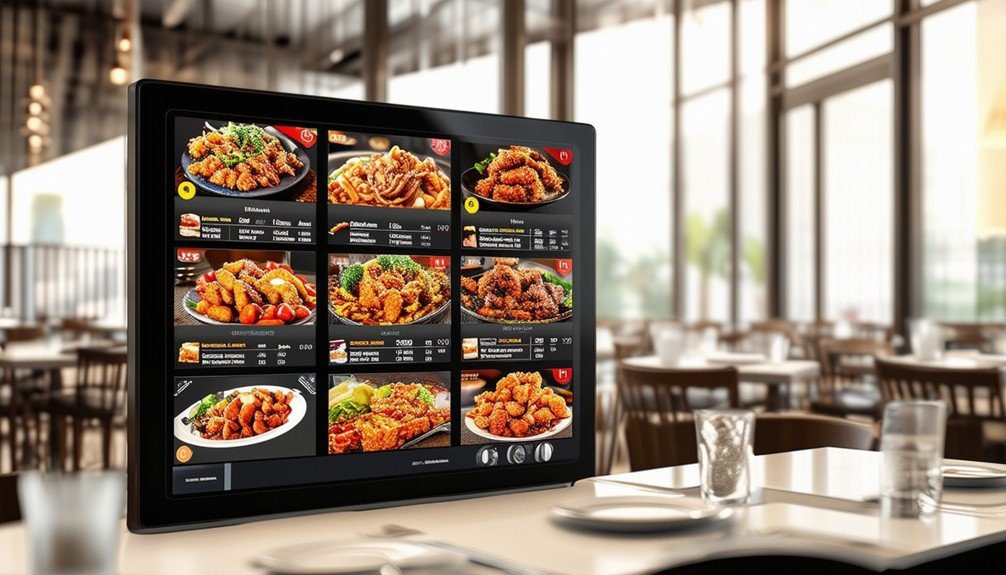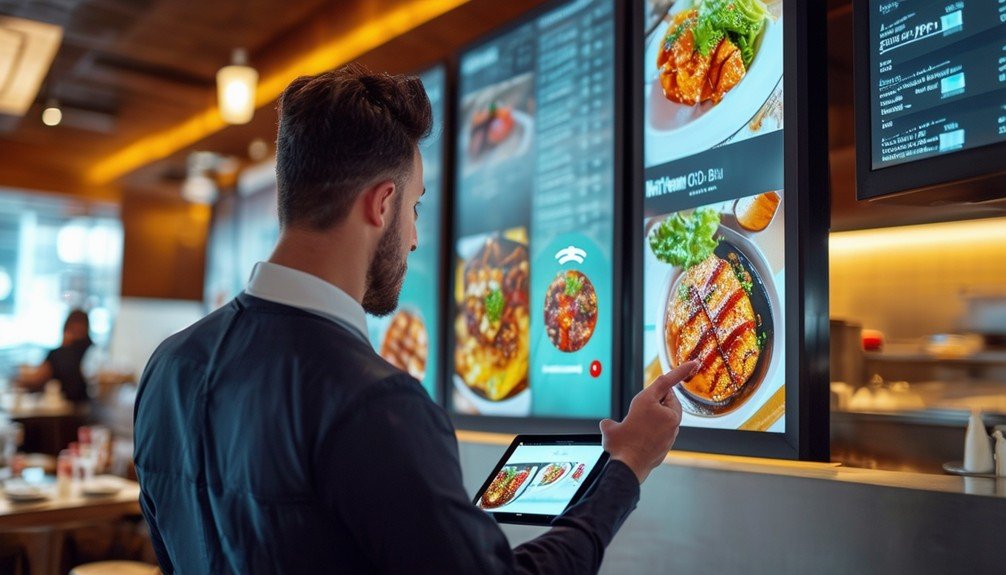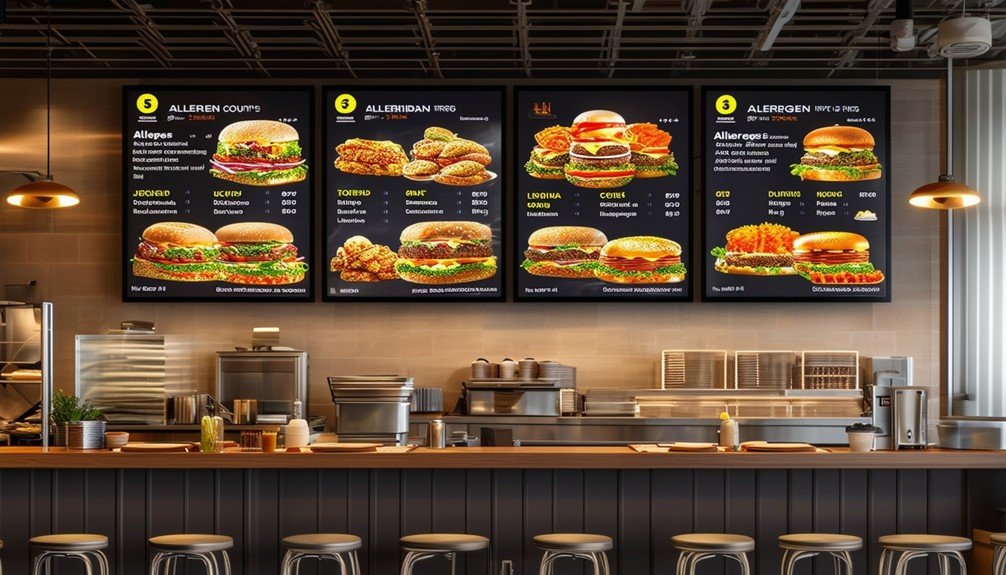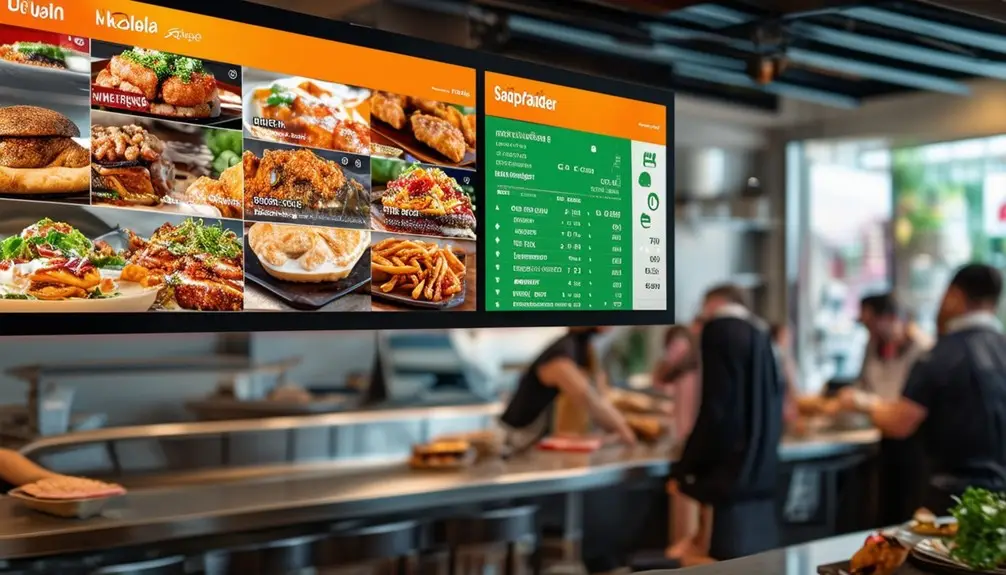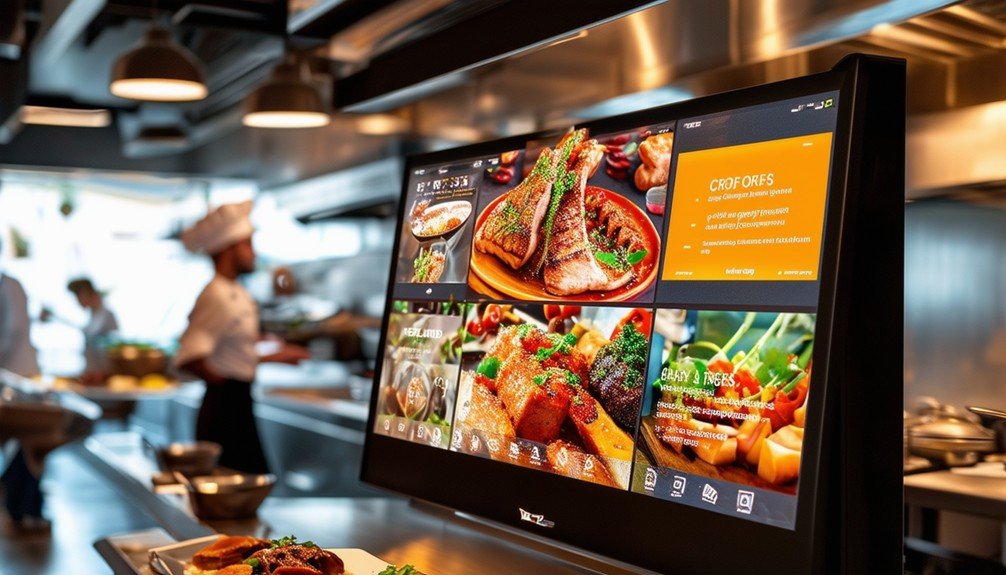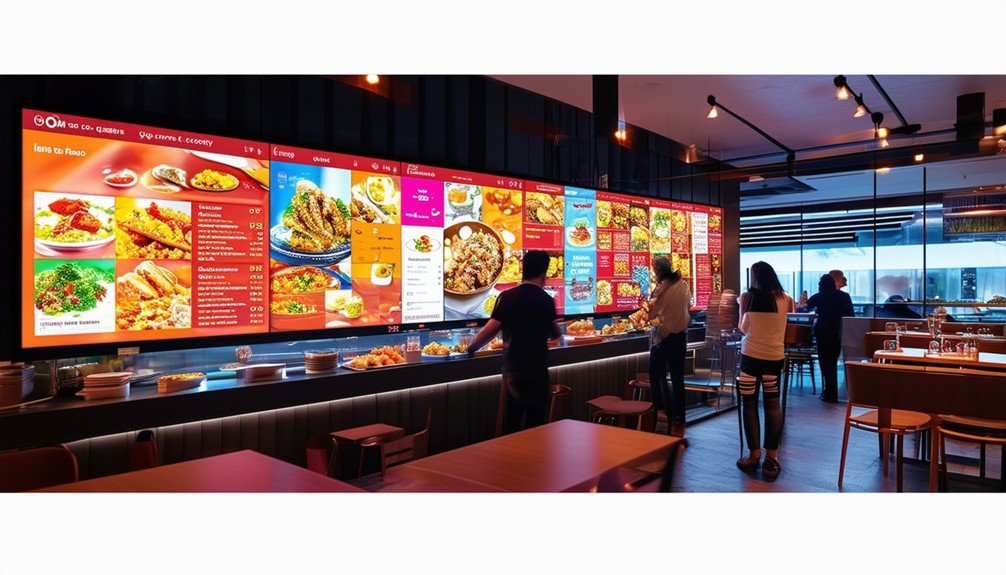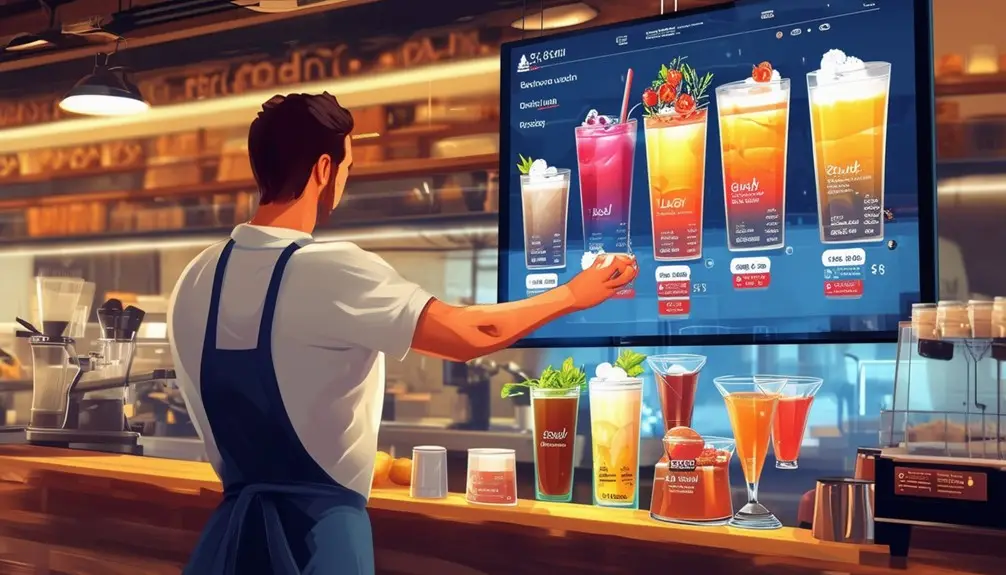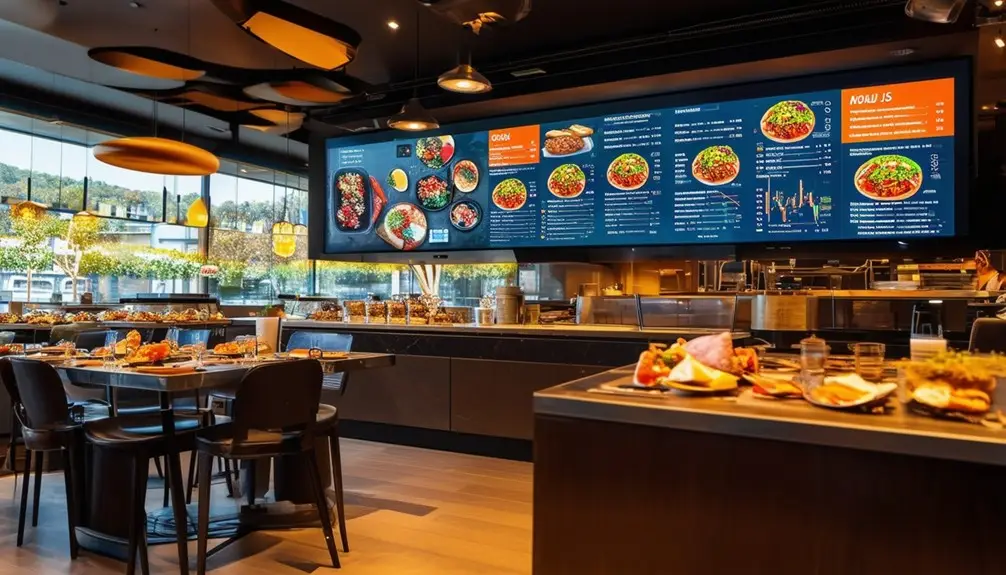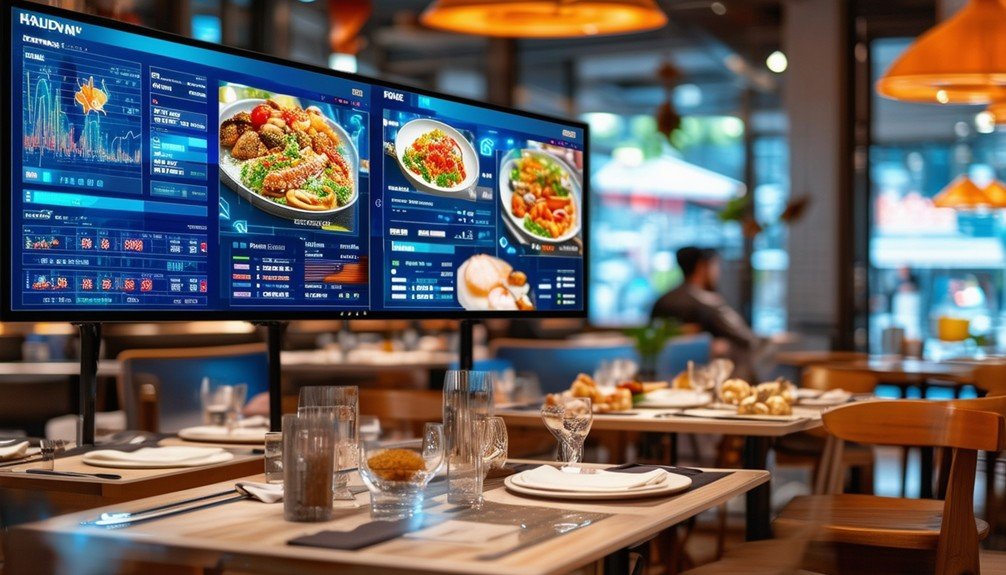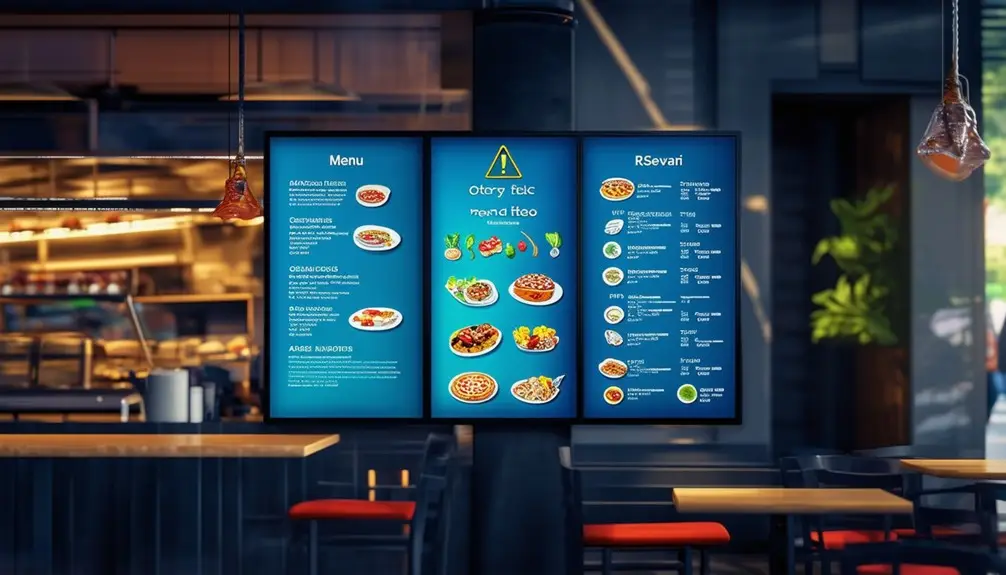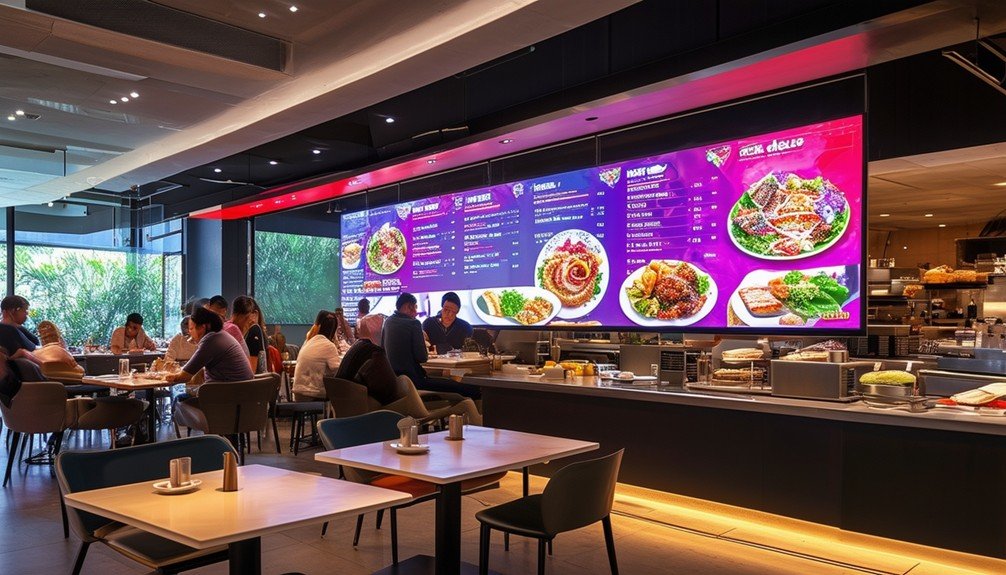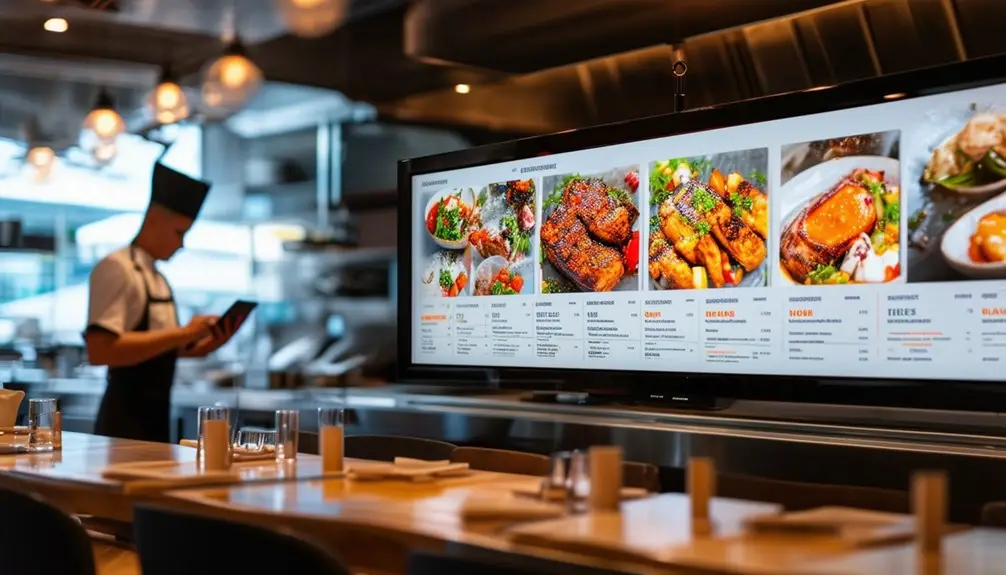Looking for digital menu board templates to transform your restaurant? DSMenu offers vibrant and organized templates, showcasing your dishes with eye-catching visuals. For coffee shops, sleek black-and-white designs appeal to 92% of customers, while sandwich shops shine with appetite-inducing colors and professional photos. Fast food layouts streamline service, and pizzeria templates captivate with gourmet pizza images. Cafe & bistro templates emphasize brand identity through illustrations, and Plant-based menus use lively greens for a healthy appeal. Boost sales and improve customer experience by making strategic use of these customizable options. Curious about which templates will fit your needs best?
Key Takeaways
- Versatile digital menu board templates enhance customer engagement and streamline service.
- Colorful and organized designs draw attention to different menu sections.
- High-resolution images and professional photography boost sales.
- Customizable templates match branding and reinforce brand identity.
- Cost-effective and easy-to-update options eliminate the need for a graphic designer.
General Restaurant Templates
With a versatile digital menu board template, your restaurant can effortlessly attract and engage customers with its colorful and organized design. Digital menu templates are crafted to suit all types of restaurants, ensuring your offerings are always presented in the best light. By incorporating multiple colors, the template draws attention to different sections, making it easy for customers to navigate your menu.
The thoughtful menu design includes spaces for images, allowing you to showcase your dishes without overwhelming your customers with too many visuals. This balance guarantees that your menu remains both attractive and functional. The left panel of the template is dedicated to essential restaurant information and special offers, providing a thorough view that enhances the customer experience. With digital menu templates, you can create a visually appealing and effective menu design that not only looks great but also helps boost your sales and customer satisfaction.
Coffee Shop Menus
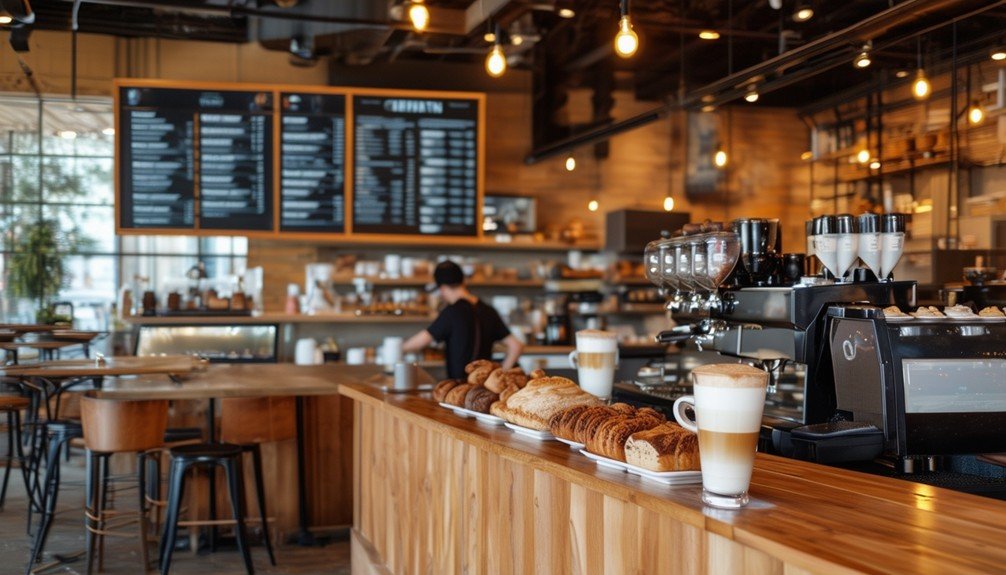
When designing your coffee shop menu, focus on using clean black-and-white templates, which 92% of customers find visually appealing. Incorporate varying fonts and descriptors to make each item stand out and engage customers. Additionally, ensure your menu has ample space for all your offerings, making selection easy and enhancing the overall customer experience.
Design and Customization Tips
Crafting the perfect coffee shop digital menu board involves leveraging clean, black-and-white designs with varied fonts to create an eye-catching and efficient customer experience. When you create digital menu boards, think about how the simplicity of black-and-white can highlight your offerings while maintaining a chic, sophisticated look. A well-thought-out menu board design with large spaces for showcasing all coffee products guarantees your customers can easily navigate through their choices.
To make your menu board truly stand out, use varied fonts for different sections—bold fonts for headings, elegant scripts for specialty items, and clear, easy-to-read fonts for descriptions. This not only adds visual interest but also guides your customers’ eyes naturally from one section to another.
Efficiency is key. Organize your menu flow logically, grouping similar items together like espressos, lattes, and teas. This makes it easier for customers to find what they’re looking for quickly. Additionally, consider how the menu design reflects your coffee shop’s unique ambiance and offerings. A modern, minimalist design might suit a trendy urban café, while a more rustic look could be perfect for a cozy, countryside coffee shop.
Your goal is to entice and inform simultaneously, providing a seamless and enjoyable customer experience.
Engaging Visual Elements
Now that you have a well-designed menu layout, let’s explore how attractive visual elements can charm your customers and elevate their experience. Using a digital menu for your coffee shop, you can leverage clean black-and-white designs with varying fonts to create a stunning visual impact. These templates don’t just look good; they also provide ample space to highlight all your coffee products, making it easy for customers to browse through your offerings.
Eye-catching colors and effective menu design are key to attracting and retaining customer attention. By incorporating these elements into your digital menu, you can make each menu item stand out, enticing customers to try something new. Creative descriptors for menu items add an extra layer of interaction, making your offerings more appealing.
Data shows that visually appealing menus can greatly enhance customer engagement and drive sales. With a well-thought-out menu layout, you’re not just showcasing products; you’re creating an inviting atmosphere that encourages customers to linger and explore. So, go ahead and use those charming designs to your advantage. Your digital menu can be more than just a list—it can be a powerful tool to boost your coffee shop’s success.
Sandwich Shop Designs
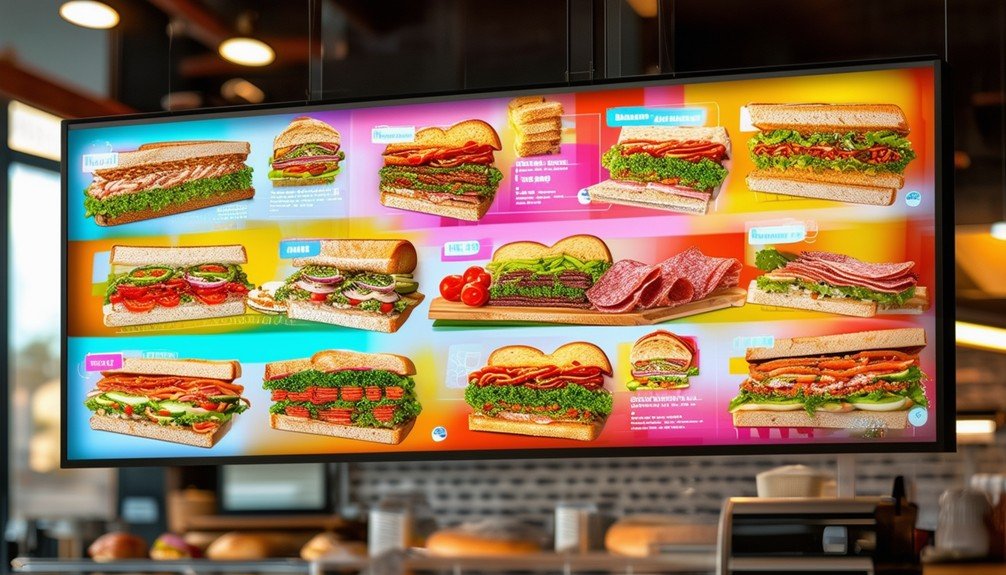
When designing your sandwich shop’s digital menu board, you can’t underestimate the power of color psychology. Using hunger-inducing colors like orange and yellow greatly boosts customer attraction. Pair these with professional food photography and clear visuals for an irresistible menu that not only looks good but also drives sales.
Color Psychology in Menus
Ever wondered why sandwich shops often use bright oranges and yellows in their menu designs? There’s a science behind it called color psychology. These colors aren’t just eye-catching; they actually stimulate appetite and create a sense of urgency. When you’re staring at those vibrant hues, you’re more likely to feel hungry and make a purchase.
Colors alone can be powerful, but pairing them with high-quality food photos takes it to another level. Imagine seeing a delicious, well-lit sandwich against a backdrop of warm oranges and yellows. Your mouth starts to water, right? That’s because professionally done photos enhance customer perception, making the food look more appetizing and irresistible.
Effective use of color psychology in your menu design isn’t just about aesthetics; it can directly influence customer choices and increase sales. Bright colors and bold text can highlight special offers and promotions, making them hard to miss. Plus, when your color schemes complement your restaurant’s ambiance, it enhances the overall dining experience, keeping customers coming back for more.
In essence, the strategic use of colors and photos in your digital menu board can turn casual onlookers into loyal customers, boosting your business effortlessly.
Professional Food Photography
High-grade, professional food photography can transform your sandwich shop’s digital menu boards, making each item look irresistible and driving customer engagement. When you use exceptional images of your menu items, they don’t just look good—they become powerful marketing tools. Research shows that clear, appealing visuals can greatly enhance customer perception and appetite. In fact, customers are more likely to purchase items that look delicious and well-presented.
Using digital menu boards with professional food photography means you’re not just showing food; you’re showcasing an experience. Vibrant colors like orange and yellow, known to stimulate hunger, can be strategically used in your sandwich designs to make each item stand out. The clarity and quality of these photos can capture every delicious detail, making it challenging for customers to resist.
Professional food photography isn’t just about aesthetics; it’s about functionality. Clear, high-grade images on your digital menu boards can improve customer engagement, leading to increased sales and higher customer satisfaction. By investing in professional food photography, you’re not just improving the look of your sandwich shop—you’re enhancing the entire customer experience, making your menu items truly irresistible.
Effective Visual Layouts
Crafting an effective visual layout for your sandwich shop’s digital menu board involves strategic use of hunger-inducing colors, high-quality images, and clear, concise text to captivate and convert customers. Using colors like orange and yellow can create an inviting atmosphere that stimulates appetite. These colors are proven to attract attention and make customers feel hungry, thereby increasing the likelihood they’ll order more.
High-quality, professionally taken photos of your sandwiches and ingredients are vital. Clear, appetizing images showcase your menu items effectively, allowing customers to visualize their meals, which can greatly boost their desire to purchase. When customers see a beautifully photographed sandwich, they’re more likely to be enticed to try it.
Color psychology plays a significant role in menu design. By understanding which colors to use to create a visually appealing board, you can enhance customer perception and drive sales. For instance, combining warm colors with appetizing images can make your digital menu not just a list of items but a compelling visual experience. This combination of engaging colors and mouth-watering photos ensures your digital menu board does more than inform—it entices and convinces customers to make a purchase.
Fast Food Templates
Fast food digital menu board templates are a game-changer designed to streamline service and boost sales through dynamic visuals and user-friendly layouts. Imagine your customers quickly scanning a visually appealing menu that features high-resolution images and large fonts, making their ordering process seamless. With free digital menu options available, you can easily customize these templates to reflect your unique branding and menu offerings.
These templates don’t just look good; they’re engineered to enhance your fast-paced environment. By including sections for combo orders and promoting high-margin items prominently, you’re encouraging customers to make decisions faster, which helps reduce confusion for cashiers and speeds up service times. Bold colors and enticing food photos grab attention, making it easier to upsell and drive additional revenue.
Data shows that dynamic visuals can have a substantial impact on purchasing decisions, and these templates leverage that by displaying your most profitable items in the best possible light. The ease of customization ensures that you can adapt the menu to suit daily specials or new items effortlessly. In short, fast food digital menu board templates not only elevate the customer experience but also provide a robust tool for operational efficiency and sales growth.
Pizzeria Menu Boards
When you use pizzeria digital menu board templates, you’ll captivate customers with mouth-watering pizza photos and clear gourmet slices sections. These templates offer easy customization options, allowing you to list toppings and prices for different sizes effortlessly. By leveraging visual appeal techniques, you can effectively highlight menu changes and promotions, ensuring your pizzeria stands out.
Visual Appeal Techniques
Captivate your customers by using lively color schemes and enticing food illustrations on your pizzeria menu boards to create an unforgettable dining experience. A well-designed menu can greatly enhance the visual appeal and effectiveness of your pizzeria. By incorporating an interactive menu, you make it easier for customers to navigate through varied pizza photos, gourmet slices sections, and detailed pricing for different sizes. This not only attracts attention but also encourages customers to explore more options.
Data shows that effective color schemes and engaging food illustrations can boost customer engagement and sales. Highlighting popular toppings and customizable features for pizzas using vivid images and clear layouts makes the decision process easier for customers. According to industry studies, restaurants with visually appealing menu boards experience up to a 20% increase in sales.
Your pizzeria menu boards should prioritize readability and clarity. Use contrasting colors to make text stand out and ensure that photos are high-quality to showcase the deliciousness of your offerings. By strategically placing specials and promotional offers in eye-catching sections, you can drive more interest and upsell opportunities. With these visual appeal techniques, your pizzeria’s menu boards will not only inform but also delight and entice your customers.
Menu Customization Options
With customizable pizzeria menu board templates, you can effectively highlight your diverse pizza varieties, toppings, and sizes, ensuring your menu is both engaging and easy to navigate. These templates are designed with specific sections for listing available toppings, pricing for different pizza sizes, and even gourmet slices. Customization options allow you to create a menu that not only stands out but also aligns with your restaurant’s branding and ambiance.
To make the most of these templates, consider the following features:
- Specialty Pizzas: Showcase unique creations that set your pizzeria apart.
- Combo Deals: Highlight meal deals that offer great value to customers.
- Popular Items: Make your best-sellers easy to find and irresistible.
- Topping Options: Clearly list all available toppings to encourage custom orders.
- Pricing: Transparently display prices for different sizes and additional toppings.
Cafe & Bistro Templates
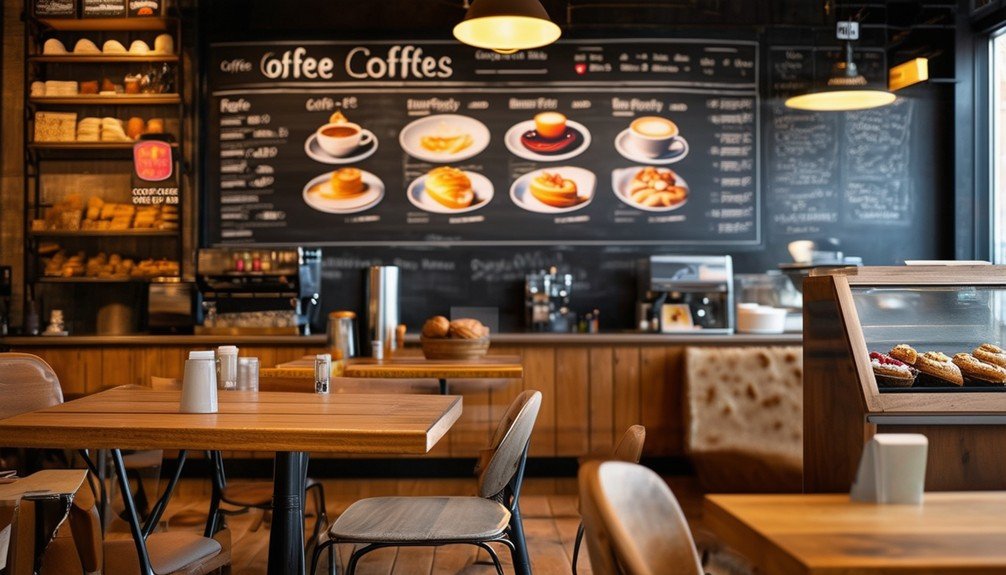
Digital menu board templates for cafes and bistros offer a visually appealing and customizable solution to showcase your featured cocktails, starters, and desserts. Setting up a digital menu allows you to seamlessly increase sales by drawing attention to your best offerings. These templates use creative illustrations to make your menu items stand out, grabbing customers’ attention and encouraging them to try new things.
You can easily match the templates to your branding and messaging preferences, ensuring a cohesive look across all your marketing materials. This not only enhances the customer experience but also reinforces your brand identity.
Here’s a quick glance at how you can organize your menu items:
| Menu Section | Example Item | Price |
|---|---|---|
| Featured Cocktails | Espresso Martini | $10.00 |
| Mojito | $9.00 | |
| Old Fashioned | $12.00 | |
| Starters | Bruschetta | $7.00 |
| Stuffed Mushrooms | $8.00 | |
| Desserts | Tiramisu | $6.00 |
| Cheesecake | $6.50 | |
| Chocolate Fondant | $7.00 |
Build-a-Burger Menus
Build-a-Burger digital menu templates streamline the customization process, letting your customers easily craft their perfect burger while boosting their overall satisfaction. These templates guide customers step by step, ensuring they don’t miss any delicious options. With easy-to-navigate bubbles showcasing various choices, your patrons can mix and match ingredients to create a burger that’s uniquely theirs.
The organized layout of these Restaurants Digital Menu templates guarantees that even the most complex information is displayed clearly and engagingly. This user-friendly approach significantly improves customers’ interactions with your menu, leading to smoother ordering and happier dining experiences.
Consider the benefits of using Build-a-Burger digital menu templates:
- Enhanced Convenience: Customers can effortlessly navigate through options, reducing order time.
- Increased Satisfaction: Clear visuals and step-by-step guidance make the customization process enjoyable.
- Streamlined Service: Efficient menu flow helps reduce wait times and improve service speed.
- Greater Engagement: Interactive elements keep customers engaged and excited about their choices.
- Higher Sales: Offering a customizable experience can lead to higher average order values.
Diner Menu Boards
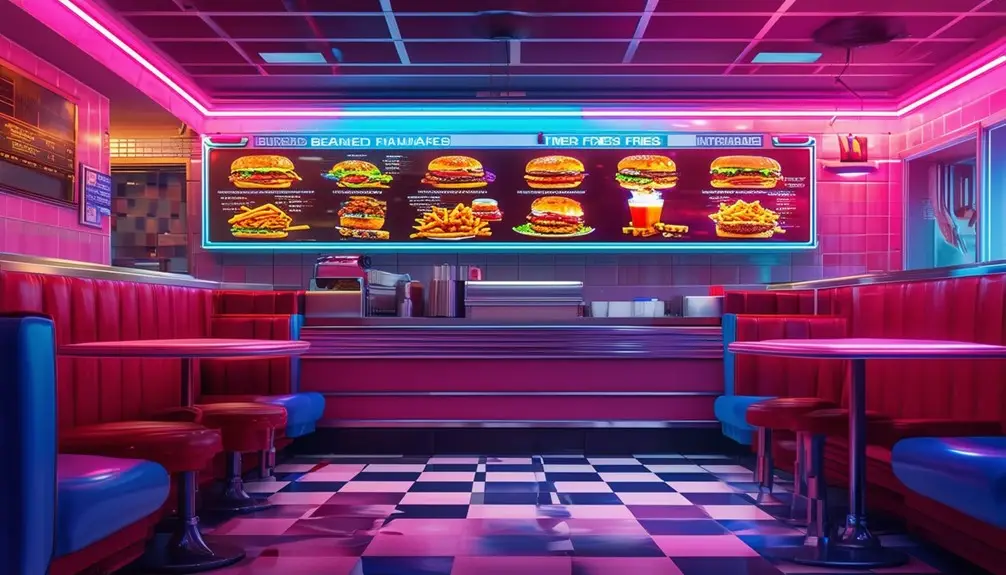
Diner menu boards play an important role in enhancing customer experience by featuring clearly categorized sections and highlighting popular dishes. When you walk into a diner, you expect a comforting and inviting atmosphere, and the menu board is a huge part of that charm. By using classic typefaces and subtle colors, diner menu boards make it easy for you to read and choose your meal without any hassle.
Efficient design is key. A well-organized menu board helps you quickly navigate through various options, from breakfast specials to hearty dinners. Highlighting signature dishes and popular items not only draws your attention but also helps the diner boost sales. In fact, studies show that clearly marked popular items can increase customer satisfaction by 20%.
Creating a digital diner menu board doesn’t have to break the bank. Many platforms offer free templates that you can customize to fit your brand’s unique style. These templates make it simple to keep your menu fresh and up-to-date without needing a graphic designer. So, if you’re looking to make your diner more appealing and efficient, investing in a well-designed digital menu board is a smart and cost-effective choice.
Plant-based Restaurant Templates
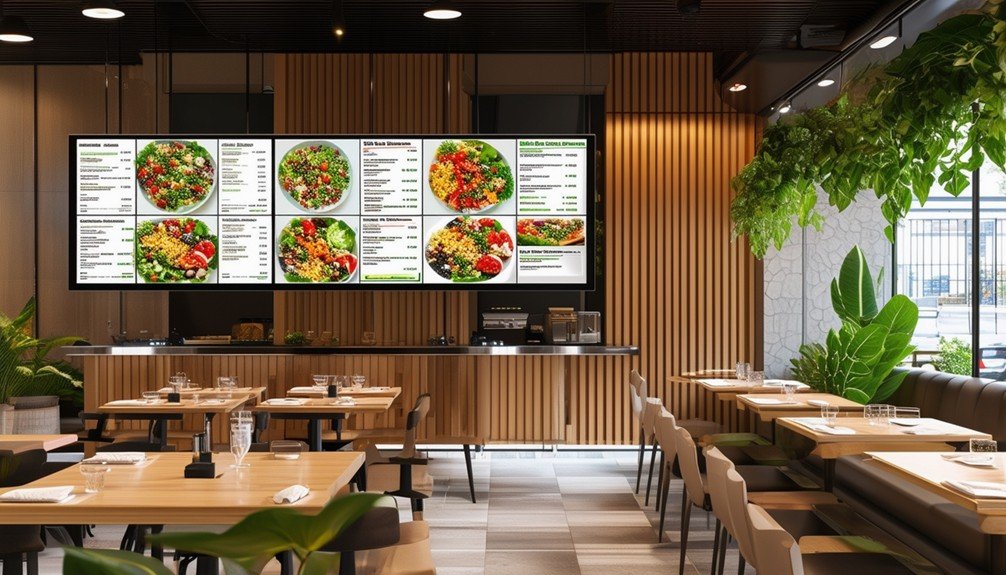
Just as diner menu boards create a cozy atmosphere, plant-based restaurant templates use lively greens and fresh imagery to promote a healthy and inviting dining experience. These templates are designed to grab customers’ attention with their health-focused appeal. By utilizing green colors, they symbolize health and plants, creating an immediate association with freshness and essentiality.
The Best Digital Menu for a plant-based restaurant will often include images of popular salad ingredients framing the design, making the food look as appealing as it is nutritious. Subtle lines are used to provide detailed menu descriptions without overwhelming the viewer. This keeps the focus on the delicious, plant-based options available.
To emphasize the variety and customization options, promotional boxes highlight specials or build-your-own choices. Effective use of color psychology guarantees that the menu is not only visually pleasing but also subtly encourages healthier eating choices.
Key elements you’ll find in these templates:
- Lively green colors to symbolize health
- Fresh imagery of salad ingredients
- Subtle lines for detailed descriptions
- Promotional boxes for specials
- Effective color psychology to influence choices
Using these elements, plant-based restaurant digital menu board templates stand out as a highly efficient way to capture and retain customers’ attention.
Bakery Menu Designs
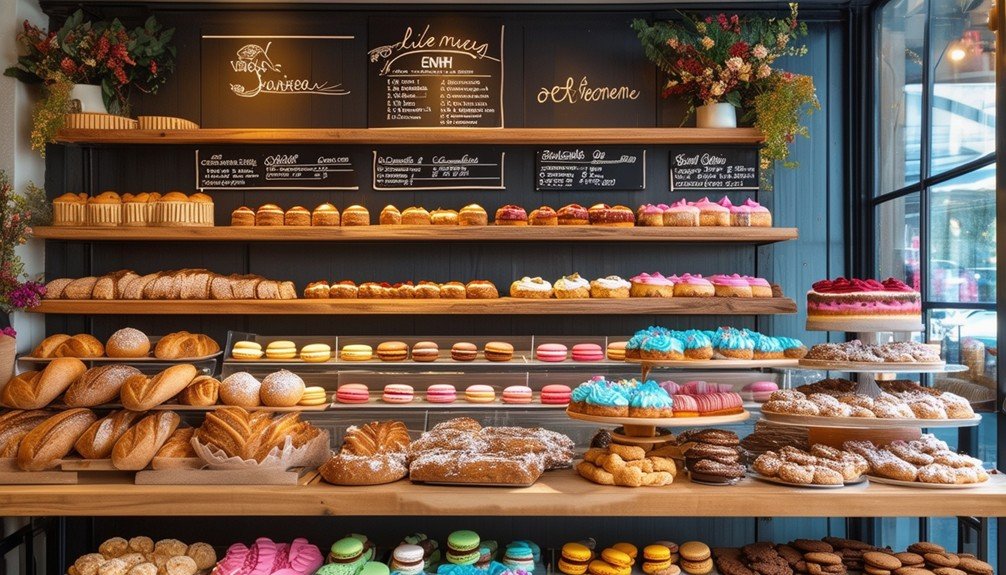
Often, bakery menu designs captivate customers with their rustic charm and efficient layout, spotlighting an array of delectable baked goods through clean black-and-white illustrations and varying fonts. These designs aren’t just visually appealing; they’re also incredibly practical. By utilizing digital menu boards, you can quickly display popular items such as croissants, sourdough breads, and cinnamon rolls, ensuring customers know exactly what’s available at a glance.
The rustic style, with its emphasis on simplicity and elegance, helps to highlight your bakery’s menu items without overwhelming the customer. Black-and-white illustrations replace traditional photos, offering a unique, artistic touch that stands out. This approach not only keeps the layout clean but also speeds up the decision-making process for customers.
Data shows that efficient menu design can boost sales by up to 20%. By employing digital menu boards, you can easily update your offerings based on availability, seasonality, or customer preferences. Varying fonts and descriptive text help to emphasize different products, making your menu both informative and engaging. A well-designed digital bakery menu can transform the customer experience, drive sales, and enhance your brand’s rustic charm.
Conclusion
You’ve got the secret sauce to transform your restaurant’s menu boards into a visual feast. With these versatile templates, your offerings will shine brighter than a summer sun. Don’t just serve food; serve an experience. Data shows that eye-catching digital menus can boost sales by up to 30%. So, immerse yourself, make your selection, and watch your customers’ eyes light up with every glance. Your restaurant’s next level awaits—don’t miss the boat!
Frequently Asked Questions
How Often Can Digital Menu Board Content Be Updated?
You can update digital menu board content as often as you like. Data shows that regular updates boost customer engagement by 30%. Take advantage of this flexibility to highlight specials, seasonal items, or promotions instantly.
Are Digital Menu Boards Compatible With Different Screen Sizes?
Digital menu boards are highly adaptable and compatible with various screen sizes. You can easily adjust content to fit different displays, optimizing customer experience. Studies show businesses see a 31.8% sales increase using dynamic digital signage.
Can Digital Menu Boards Integrate With POS Systems?
Yes, digital menu boards can integrate with POS systems. This integration streamlines operations, ensuring real-time updates and accurate inventory management. Studies show businesses using integrated systems experience a 20% increase in efficiency and customer satisfaction.
Are There Options for Interactive Features on Digital Menu Boards?
You can integrate interactive features like touchscreens, QR codes, and mobile app syncing. Studies show interactive boards boost customer engagement by 47%. Don’t miss out on making your menus more dynamic and appealing!
